Ingenico IWL2XXWBCL WIFI, Bluetooth and Contactless Point of Sales terminal User Manual Report
INGENICO WIFI, Bluetooth and Contactless Point of Sales terminal Report
Ingenico >
Contents
- 1. Technical Manual
- 2. Users Manual
Technical Manual
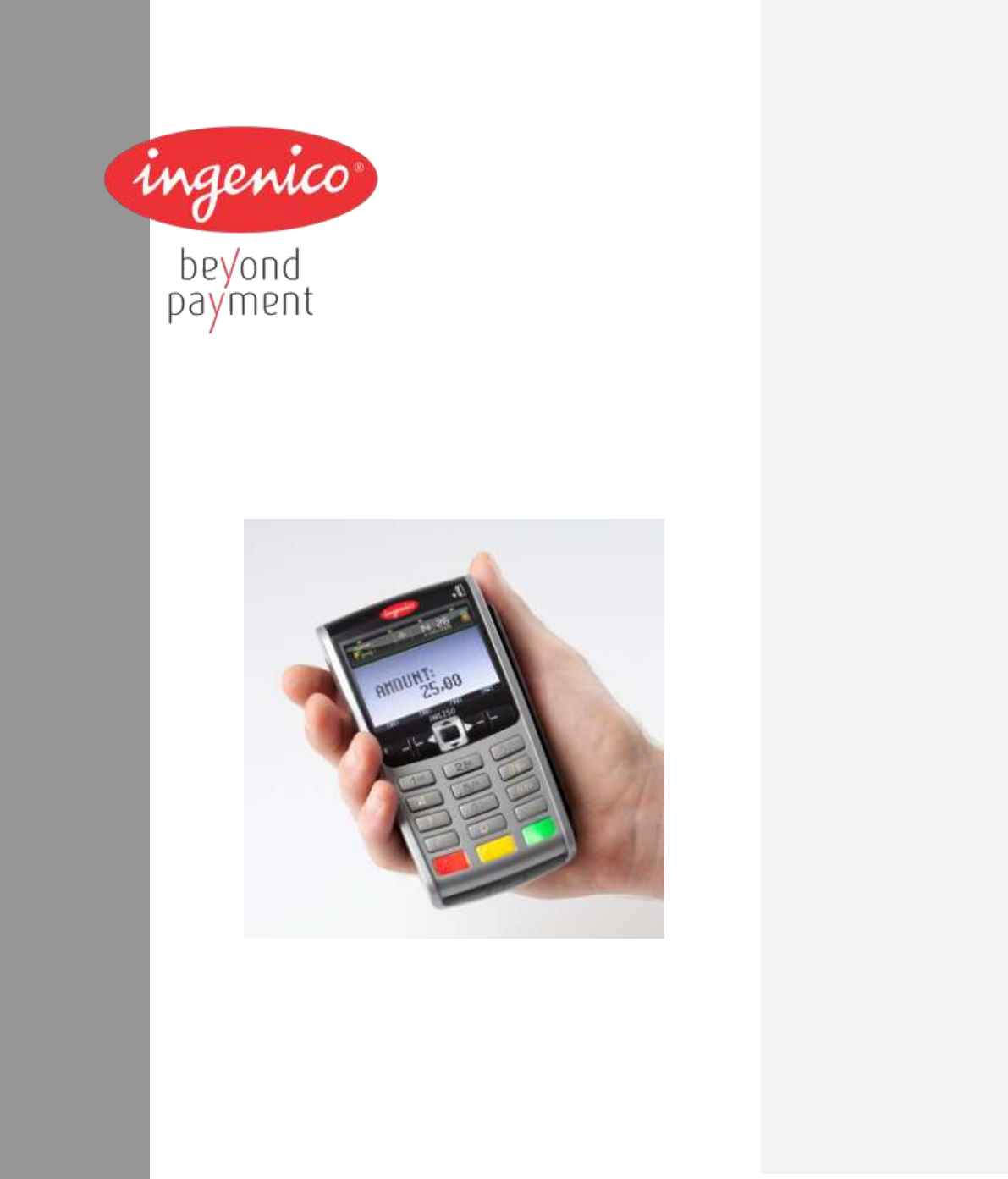
Ingenico - 190-192 avenue Charles de Gaulle - 92200 Neuilly-sur-Seine
Tél. 33(0)1 46 25 82 00 - Fax 33 (0)1 47 72 56 95 – www.ingenico.com
iWL220/250
Technical Manual

Technical manual _iWL220/250
ICO_MKP_009_GU_EN_V4
2/60
Copyright © 2010 Ingenico
All rights reserved

Technical manual _iWL220/250
ICO_MKP_009_GU_EN_V4
3/60
Copyright © 2010 Ingenico
All rights reserved
Contents
1. Document __________________________________________________ 11
1.1. Document change history______________________________________________ 11
1.2. Document sign off ____________________________________________________ 11
2. Equipment __________________________________________________ 13
2.1. Introduction _________________________________________________________ 13
2.2. General hardware description __________________________________________ 13
2.2.1. Terminal’s description _________________________________________________________ 13
2.2.1.1. Dimensions & weight __________________________________________________________ 13
2.2.1.1.1. With 25 mm paper roll ______________________________________________________ 13
2.2.1.1.2. With 40 mm paper roll _____________________________________________________ 14
2.2.1.2. Functional overview ________________________________________________________ 14
2.2.2. Base description ______________________________________________________________ 16
2.3. Technical hardware characteristics ______________________________________ 16
2.3.1. Processor ____________________________________________________________________ 16
2.3.2. Memory capacity ______________________________________________________________17
2.3.3. Booster ______________________________________________________________________17
2.3.4. Data security __________________________________________________________________17
2.3.4.1. Hardware design ____________________________________________________________17
2.3.4.2. Software design ___________________________________________________________ 18
2.3.4.3. Product activation _________________________________________________________ 18
2.3.5. The isolation mechanism by electronic locking system _______________________________ 18
2.3.5.1. Isolation __________________________________________________________________ 18
2.3.5.2. MMU features _____________________________________________________________ 19
2.3.5.3. Inviolable memory protection ________________________________________________ 19
2.3.5.4. OS is inviolable and protected ________________________________________________ 19
2.3.5.5. The OS ensures the inter-violability of software application ________________________ 19
2.3.6. Card readers _________________________________________________________________ 19
2.3.6.1. Main smart card reader _____________________________________________________ 19
2.3.6.2. 2nd card reader ____________________________________________________________ 20

Technical manual _iWL220/250
ICO_MKP_009_GU_EN_V4
4/60
Copyright © 2010 Ingenico
All rights reserved
2.3.6.3. Magnetic stripe reader _______________________________________________________ 21
2.3.6.4. Contactless reader __________________________________________________________ 21
2.3.6.4.1. Introduction to Contactless _________________________________________________ 22
2.3.6.4.2. What is Contactless card payment? __________________________________________ 23
2.3.6.4.3. The advantages of Contactless technology ____________________________________ 23
2.3.6.5. SAM readers ______________________________________________________________ 23
2.3.7. Keypad , navigation pad ________________________________________________________ 24
2.3.8. Display ______________________________________________________________________ 25
2.3.9. Printer ______________________________________________________________________ 25
2.3.10. Audio _______________________________________________________________________ 26
2.3.11. Battery ______________________________________________________________________ 26
2.3.12. Power supply unit _____________________________________________________________ 27
3. Connectivity ________________________________________________ 29
3.1. On terminal _________________________________________________________ 29
3.1.1. Wired Connectivity: ____________________________________________________________ 29
3.1.1.1. micro USB type A/B ____________________________________________________________ 29
3.1.1.2. Base Interface _____________________________________________________________ 29
3.1.2. Wireless Connectivity __________________________________________________________ 30
3.1.2.1. GPRS ____________________________________________________________________ 30
3.1.2.2. 3G - HSDPA _______________________________________________________________ 30
3.1.2.3. Bluetooth ________________________________________________________________ 31
3.1.2.4. Wifi _____________________________________________________________________ 31
3.2. On base ____________________________________________________________ 31
3.2.1. Base charger _________________________________________________________________ 33
3.2.2. USB ________________________________________________________________________ 33
3.2.3. Bluetooth ___________________________________________________________________ 34
3.2.4. Modem (PSTN) _______________________________________________________________ 34
3.2.5. Ethernet_____________________________________________________________________ 35
4. Standards __________________________________________________ 37
4.1. Immunity characteristics_______________________________________________ 37
4.2. Disturbance produced by the equipment _________________________________ 37
4.3. Operating conditions _________________________________________________ 37
4.4. Storage conditions ___________________________________________________ 37

Technical manual _iWL220/250
ICO_MKP_009_GU_EN_V4
5/60
Copyright © 2010 Ingenico
All rights reserved
5. Norms and certifications ______________________________________ 39
6. Software ___________________________________________________ 41
6.1. Software architecture _________________________________________________ 41
6.2. Memory space allocation ______________________________________________ 42
6.3. Software security management _________________________________________ 43
6.4. Operating system ____________________________________________________ 43
6.4.1. Bootstrap ___________________________________________________________________ 43
6.4.2. Operating system (OS) characteristics ____________________________________________ 44
6.5. Manager ____________________________________________________________ 45
6.5.1. Terminal initialisation __________________________________________________________ 45
6.5.2. Terminal maintenance _________________________________________________________ 45
6.6. Software downloading ________________________________________________ 47
6.6.1. Downloading _________________________________________________________________ 47
6.6.2. LLT(Local Loading Tool) ________________________________________________________ 47
6.6.3. Downloading by USB key _______________________________________________________ 48
6.6.4. TMS (Terminal Management Server) ______________________________________________ 48
6.6.5. Downloading and managing memory allocation in the terminal ________________________ 48
6.6.6. Improved software downloading ________________________________________________ 48
6.6.7. Starting the downloading _______________________________________________________ 49
6.7. Development workstation _____________________________________________ 50
7. TMS _______________________________________________________ 51
7.1. Introduction _________________________________________________________ 51
7.2. Basic functions ______________________________________________________ 51
7.3. Advanced functions __________________________________________________ 51
7.4. Customer savings with Ingenico TMS solution _____________________________ 52
8. Glossary ____________________________________________________ 53
1. Document ___________________________________________________ 7
1.1. Document change history_______________________________________________ 7

Technical manual _iWL220/250
ICO_MKP_009_GU_EN_V4
6/60
Copyright © 2010 Ingenico
All rights reserved
1.2. Document sign off _____________________________________________________ 7
2. Equipment ___________________________________________________ 9
2.1. Introduction __________________________________________________________ 9
2.2. General hardware description ___________________________________________ 9
2.2.1. Terminal’s description __________________________________________________________ 9
2.2.1.1. Dimensions & weight ___________________________________________________________ 9
2.2.1.1.1. With 25 mm paper roll _______________________________________________________ 9
2.2.1.1.2. With 40 mm paper roll _____________________________________________________ 10
2.2.1.2. Functional overview ________________________________________________________ 10
2.2.2. Base description _______________________________________________________________ 12
2.3. Technical hardware characteristics ______________________________________ 12
2.3.1. Processor _____________________________________________________________________ 12
2.3.2. Memory capacity _____________________________________________________________ 13
2.3.3. Booster _____________________________________________________________________ 13
2.3.4. Data security _________________________________________________________________ 13
2.3.4.1. Hardware design ___________________________________________________________ 13
2.3.4.2. Software design ___________________________________________________________ 14
2.3.4.3. Product activation _________________________________________________________ 14
2.3.5. The isolation mechanism by electronic locking system _______________________________ 14
2.3.5.1. Isolation __________________________________________________________________ 14
2.3.5.2. MMU features _____________________________________________________________ 15
2.3.5.3. Inviolable memory protection ________________________________________________ 15
2.3.5.4. OS is inviolable and protected ________________________________________________ 15
2.3.5.5. The OS ensures the inter-violability of software application ________________________ 15
2.3.6. Card readers _________________________________________________________________ 15
2.3.6.1. Main smart card reader _____________________________________________________ 15
2.3.6.2. 2nd card reader ____________________________________________________________ 16
2.3.6.3. Magnetic stripe reader _______________________________________________________17
2.3.6.4. Contactless reader __________________________________________________________17
2.3.6.4.1. Introduction to Contactless ________________________________________________ 18
2.3.6.4.2. What is Contactless card payment? __________________________________________ 19
2.3.6.4.3. The advantages of Contactless technology ____________________________________ 19
2.3.6.5. SAM readers ______________________________________________________________ 19
2.3.7. Keypad , navigation pad ________________________________________________________ 20
2.3.8. Display _______________________________________________________________________ 21
2.3.9. Printer _______________________________________________________________________ 21

Technical manual _iWL220/250
ICO_MKP_009_GU_EN_V4
7/60
Copyright © 2010 Ingenico
All rights reserved
2.3.10. Audio _______________________________________________________________________ 22
2.3.11. Battery ______________________________________________________________________ 22
2.3.12. Power supply unit _____________________________________________________________ 23
3. Connectivity ________________________________________________ 25
3.1. On terminal _________________________________________________________ 25
3.1.1. Wired Connectivity: ____________________________________________________________ 25
3.1.1.1. micro USB type A/B ____________________________________________________________ 25
3.1.1.2. Base Interface _____________________________________________________________ 25
3.1.2. Wireless Connectivity __________________________________________________________ 26
3.1.2.1. GPRS ____________________________________________________________________ 26
3.1.2.2. Bluetooth ________________________________________________________________ 26
3.2. On base ____________________________________________________________ 27
3.2.1. Base charger _________________________________________________________________ 28
3.2.2. USB ________________________________________________________________________ 28
3.2.3. Bluetooth ___________________________________________________________________ 29
3.2.4. Modem (PSTN) _______________________________________________________________ 29
3.2.5. Ethernet_____________________________________________________________________ 30
4. Standards __________________________________________________ 31
4.1. Immunity characteristics_______________________________________________ 31
4.2. Disturbance produced by the equipment _________________________________ 31
4.3. Operating conditions _________________________________________________ 31
4.4. Storage conditions ___________________________________________________ 31
5. Norms and certifications ______________________________________ 33
6. Software ___________________________________________________ 35
6.1. Software architecture _________________________________________________ 35
6.2. Memory space allocation ______________________________________________ 36
6.3. Software security management _________________________________________ 37
6.4. Operating system ____________________________________________________ 37
6.4.1. Bootstrap ___________________________________________________________________ 37
6.4.2. Operating system (OS) characteristics ____________________________________________ 38

Technical manual _iWL220/250
ICO_MKP_009_GU_EN_V4
8/60
Copyright © 2010 Ingenico
All rights reserved
6.5. Manager ____________________________________________________________ 39
6.5.1. Terminal initialisation __________________________________________________________ 39
6.5.2. Terminal maintenance _________________________________________________________ 39
6.6. Software downloading ________________________________________________ 41
6.6.1. Downloading _________________________________________________________________ 41
6.6.2. LLT(Local Loading Tool) ________________________________________________________ 41
6.6.3. Downloading by USB key _______________________________________________________ 42
6.6.4. TMS (Terminal Management Server) ______________________________________________ 42
6.6.5. Downloading and managing memory allocation in the terminal ________________________ 42
6.6.6. Improved software downloading ________________________________________________ 42
6.6.7. Starting the downloading _______________________________________________________ 43
6.7. Development workstation _____________________________________________ 44
7. TMS _______________________________________________________ 45
7.1. Introduction _________________________________________________________ 45
7.2. Basic functions ______________________________________________________ 45
7.3. Advanced functions __________________________________________________ 45
7.4. Customer savings with Ingenico TMS solution _____________________________ 46
8. Glossary ____________________________________________________ 47

Technical manual _iWL220/250
ICO_MKP_009_GU_EN_V4
9/60
Copyright © 2010 Ingenico
All rights reserved
Legend:
This symbol indicates a process to follow.
This symbol indicates an important warning.
Italic typeface in a frame indicates a piece of information.
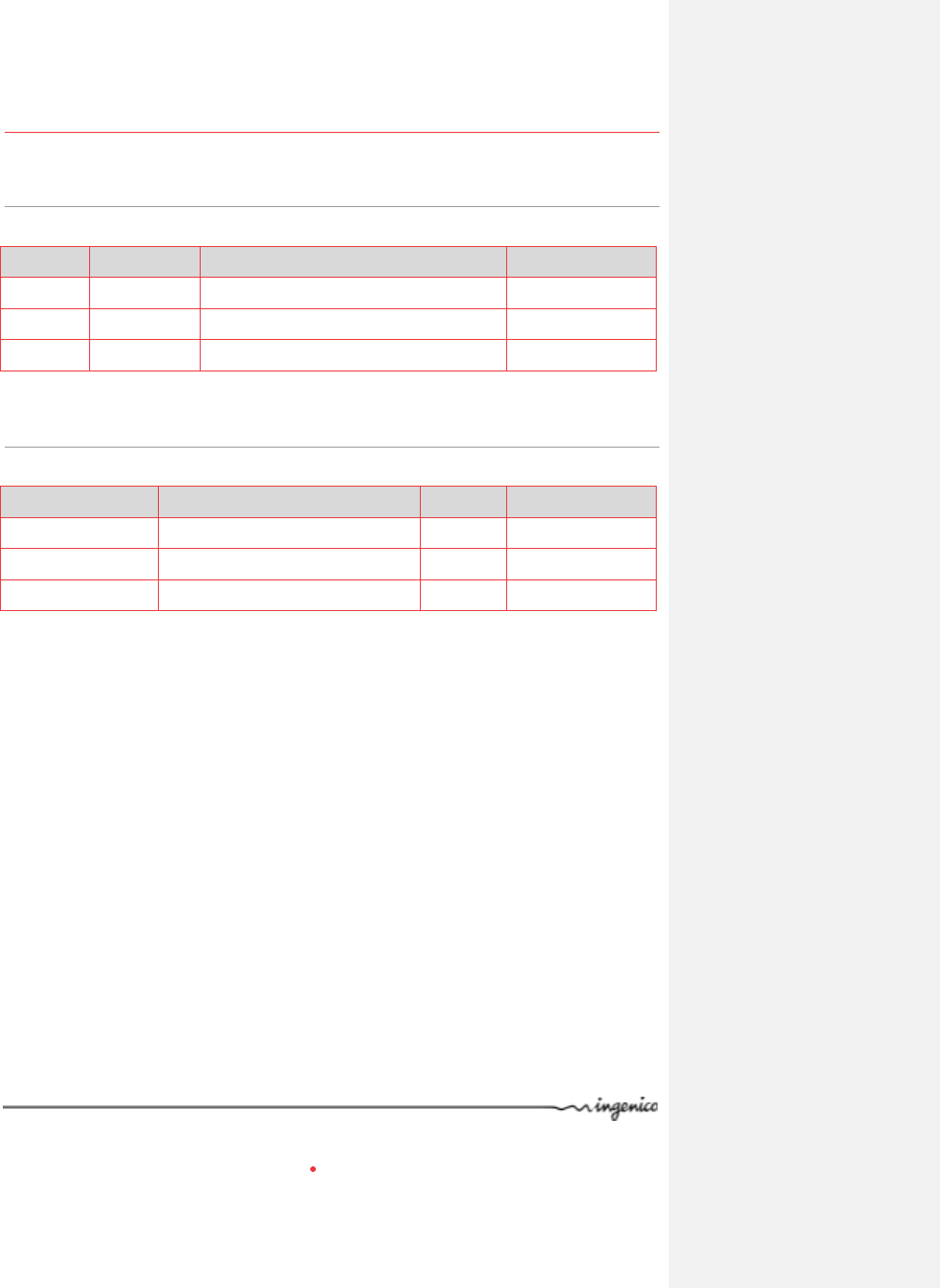
Technical manual _iWL220/250
ICO_MKP_009_GU_EN_V4
11/60
Copyright © 2010 Ingenico
All rights reserved
1. Document
1.1. Document change history
Version
Date
Changes
Author
V1
August 2010
Creation
L. LOMBARD
V2
Dec. 2010
Evolutions
C. JEANNEAU
V3
June 2012
Up-date 3G
G. ANDRE
1.2. Document sign off
Name
Title
Date
Signature
V. FILLAUD
Product Management Mobility
C. LARINIER
R&D Product Manager
G. ANDRE
Marketing Product Manager

Technical manual _iWL220/250
ICO_MKP_009_GU_EN_V4
13/60
Copyright © 2010 Ingenico
All rights reserved
2. Equipment
2.1. Introduction
This document is aimed at describing from a technical perspective the Ingenico’s new range
of mobile terminals, the iWL series.
The iWL range has been developed to address all the mobility payment needs, even in the
most demanding situations. From pay-at-table to taking payment on-the-move, all iWL
terminals have been designed around the core of Ingenico’s innovative technology and
security expertise, bringing to the market the first pocket-sized wireless payment device
and the most comprehensive portable range ever.
The iWL range is composed of 2 models:
iWL220
iWL250
This Technical Guide is mainly geared to meet the needs of the regions when answering
tenders. It can be used as a Reference Guide for any specification-related question.
This document is internal to Ingenico and should not be communicated to any
customer.
For further information, you can refer to the sales guide and the user guide.
2.2. General hardware description
2.2.1. Terminal’s description
2.2.1.1. Dimensions & weight
2.2.1.1.1. With 25 mm paper roll
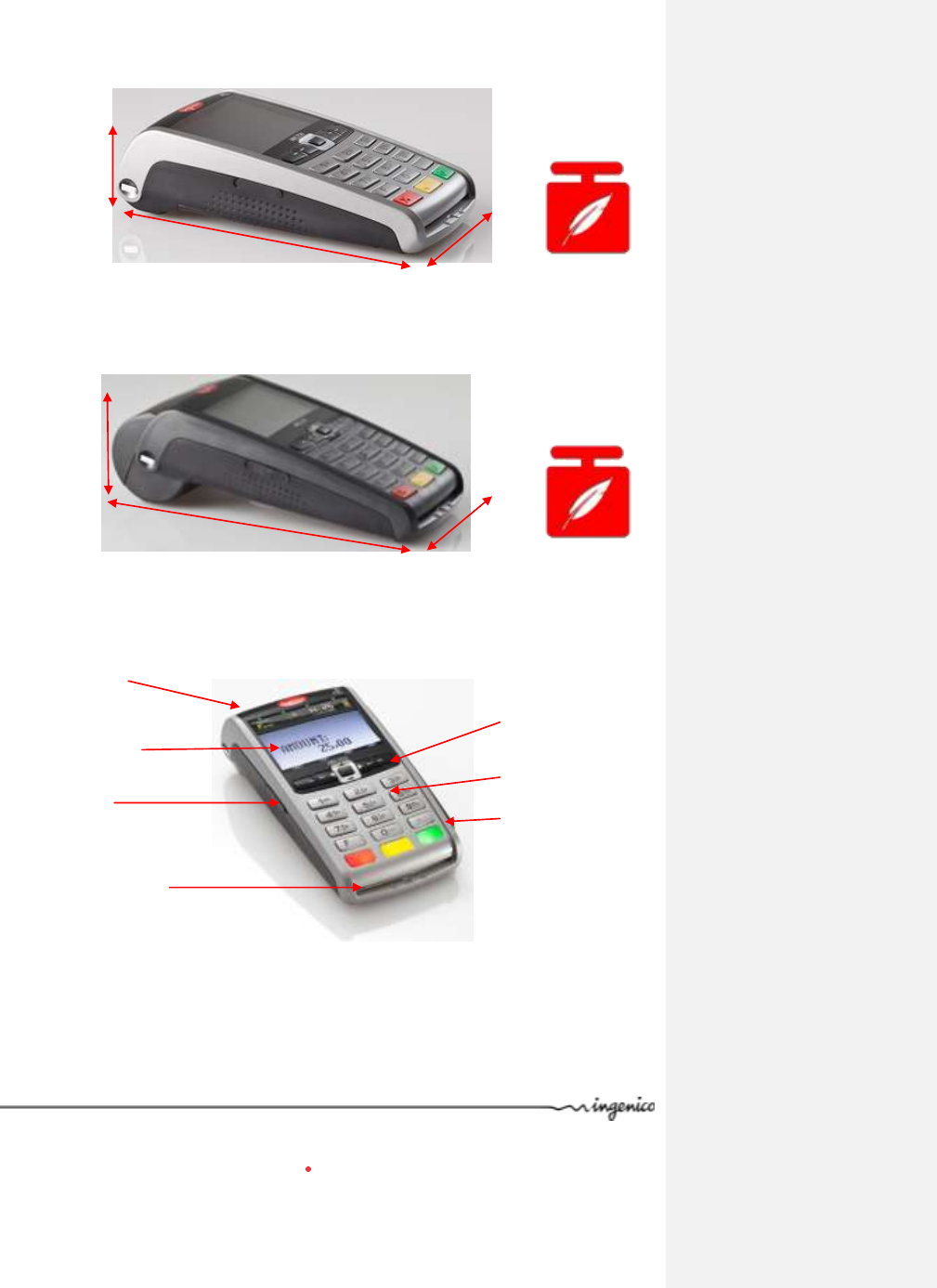
Technical manual _iWL220/250
ICO_MKP_009_GU_EN_V4
14/60
Copyright © 2010 Ingenico
All rights reserved
2.2.1.1.2. With 40 mm paper roll
2.2.1.2. Functional overview
150 mm
44mm
285 g
78 mm
300 g
54mm
78 mm
Easy loading printer
Large graphic display
USB Connector
Navigation keys
Backlit keyboard
Smart card reader
Magnetic card reader
165 mm
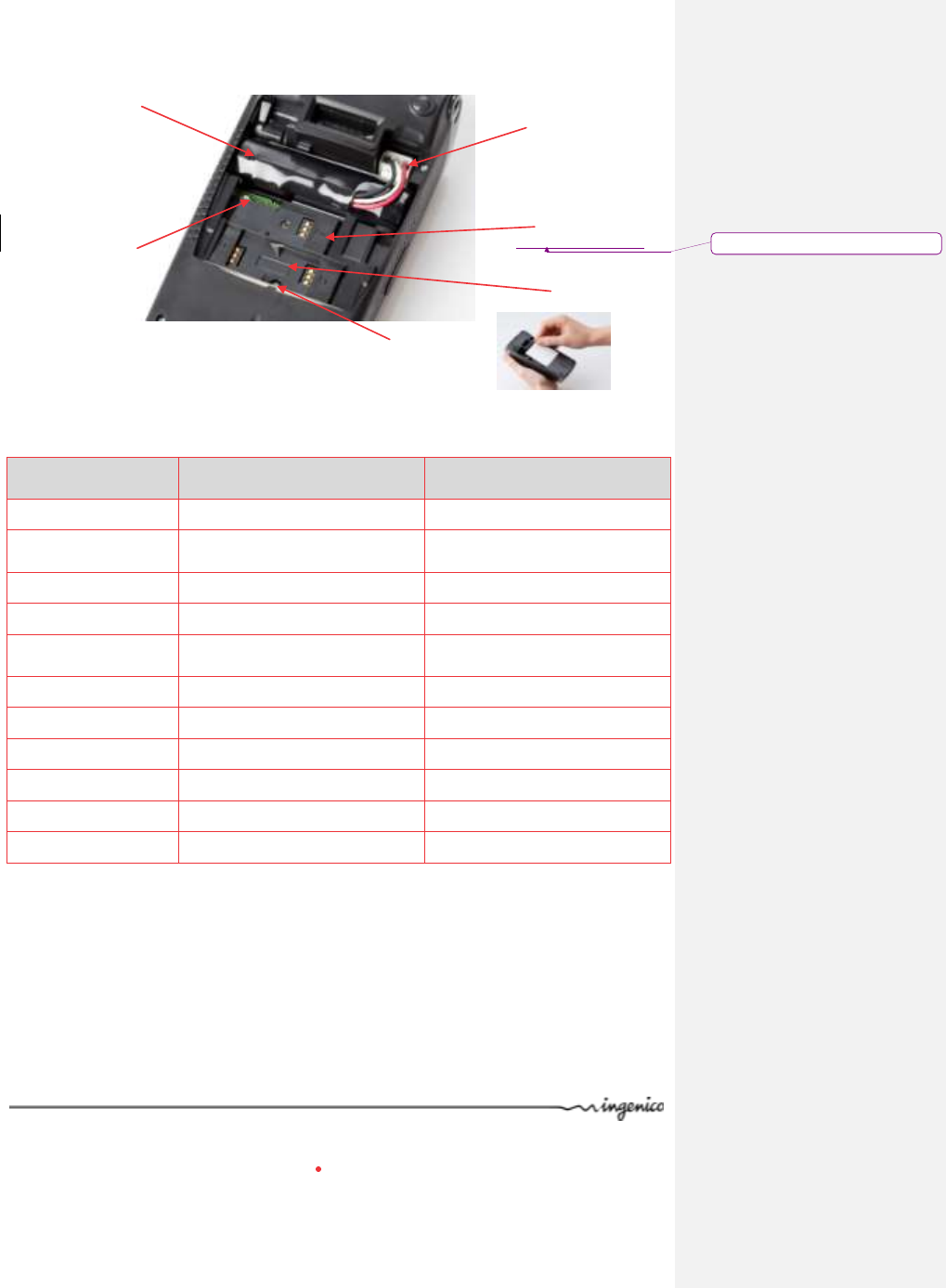
Technical manual _iWL220/250
ICO_MKP_009_GU_EN_V4
15/60
Copyright © 2010 Ingenico
All rights reserved
Model
iWL220/250
with 25mm paper roll
iWL220/250
with 40 mm paper roll
Type
Monochrome
Color
Display area
2.51”
56,3 x 31,3 mm
2.81”
57,1 x 42,8 mm
Number of pixels
128 x64
320 x 240 (QVGA)
Number of keys
15 keys
15 keys
Function & navigation
keys
7 keys
7 keys
Keyboard
Backlit
Backlit
Buzzer
Up to 60 dB
Up to 60 dB
Audio speaker
-
Optional
External dimensions
150 (l) x 44 (H) x 78 (W) mm
165 (l) x 54 (H) x 78 (W) mm
Weight
285g
300g
Casing material
Baked in ABS-PC
Baked in ABS-PC
Li-ion battery
2050mAh
Battery connector
2 SAMs SLOT
SIM Slot
(or 3rd SAM Option)
Micro-SD reader
2nd Smart card reader
(optional)
Mis en forme : Exposant
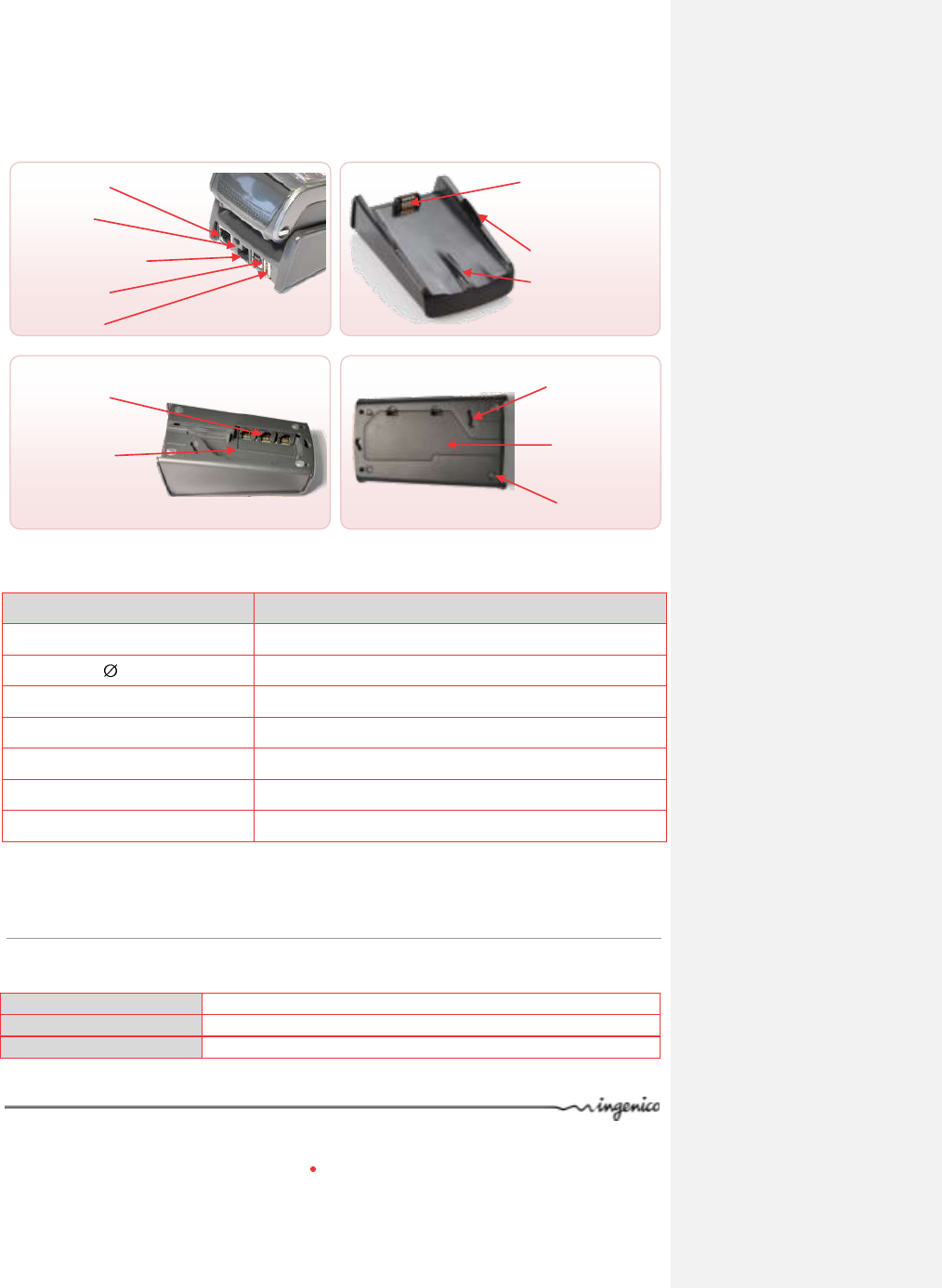
Technical manual _iWL220/250
ICO_MKP_009_GU_EN_V4
16/60
Copyright © 2010 Ingenico
All rights reserved
2.2.2. Base description
Connector
Description
Terminal interface
USB link between Base and Terminal
Jack female ( 3,5 – 1,3mm)
PSU connector
USB-A (Host)
Host port
USB-B (Slave)
Slave port
RJ11
Up to 2 RS232 ports for serial links
RJ11
Dial-up Modem
RJ45
Ethernet 10/100 Base T
2.3. Technical hardware characteristics
2.3.1. Processor
Main CPU
RISC 32-bits ARM9 processor
Clock frequency
380 MHz
Capacity
450 MIPS
Ethernet Port
Power Jack
Cable management
USB B (Slave)
USB A (Host)
Highly resistant
connector
allowing 300k
dockings
Guiding areas
allowing a single
gesture docking
Modem &
RS232 ports
Cable
Management
cage
Connectors
door
Locking
keyhole
Anti-slip
bumpers
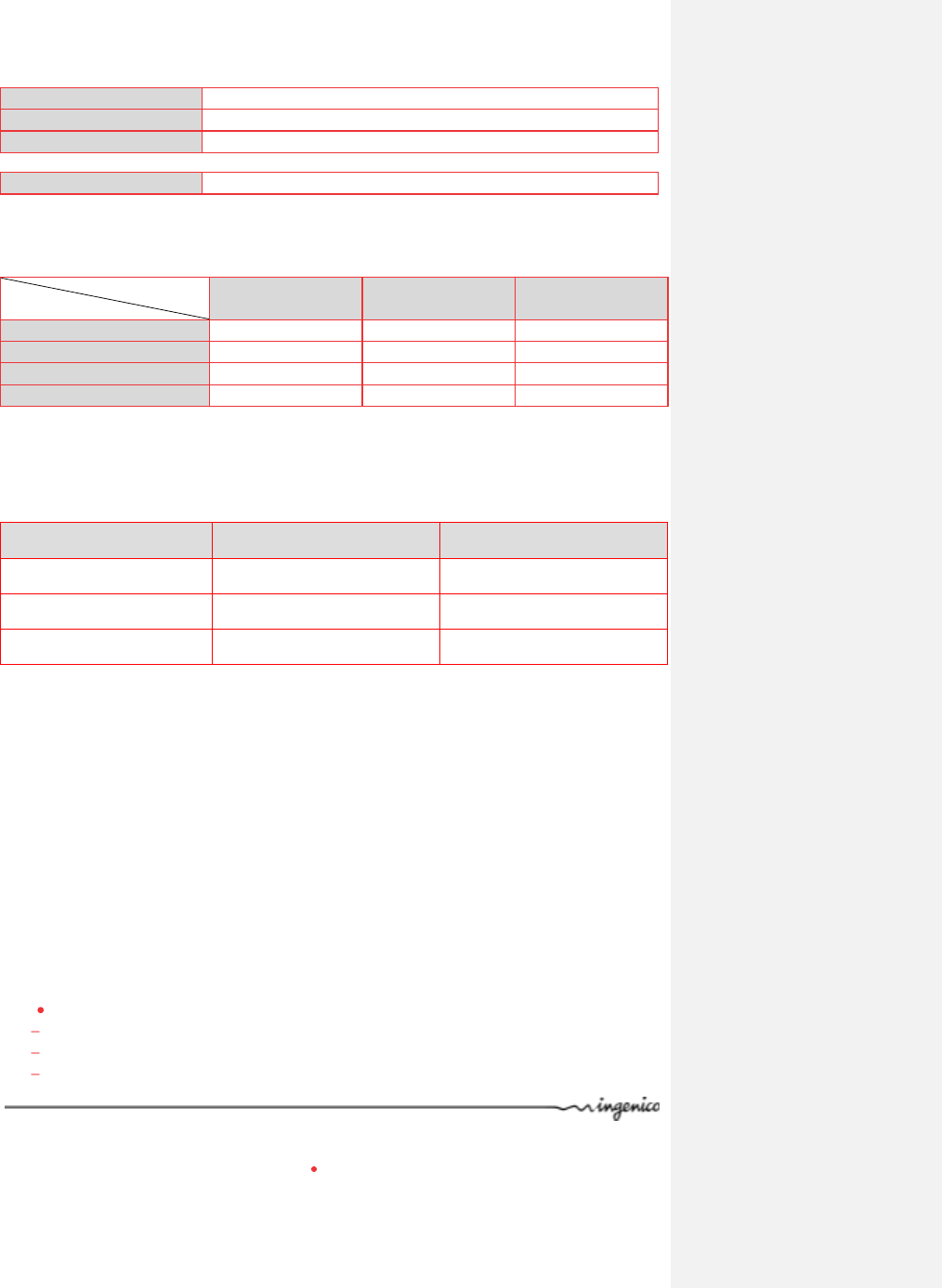
Technical manual _iWL220/250
ICO_MKP_009_GU_EN_V4
17/60
Copyright © 2010 Ingenico
All rights reserved
CRYPTO CPU (booster)
RISC 32-bits ARM7 processor with flash and RAM memory
Clock frequency
57 MHz
Capacity
50 MIPS
Calendar
Leap-year management
The power of the iWL2xx’s processors gives the following performance:
3DES less than 10µs.
Algorithm
Keys
RSA
SDA
DDA
1024 exp 3
0,4 ms
1 ms
1,5 ms
1024 exp 216 + 1
3 ms
8 ms
13 ms
2048 exp 3
1,1 ms
3 ms
4,5 ms
2048 exp 216 + 1
9 ms
24 ms
38 ms
2.3.2. Memory capacity
Memory
iWL220
iWL250
Internal SDRAM
16MB up to 32MB
32MB
Internal Flash
16MB up to 128MB
128MB
µSD card reader
Optional
Standard
2.3.3. Booster
The booster is a secured ASIC (crypto processor) including all the secured functions which
protect the device against various attacks.
The booster embedded has an impact on security personalization.
2.3.4. Data security
2.3.4.1. Hardware design
The terminal was designed to be tamper sensitive, in order to preserve the sensitive data
(keys or confidential code) and to delete this data as soon as a tamper attempt is detected.
Tamper detection
Protection against tampering:
By micro switches
By temperature monitoring

Technical manual _iWL220/250
ICO_MKP_009_GU_EN_V4
18/60
Copyright © 2010 Ingenico
All rights reserved
By voltage monitoring
By CPU clock monitoring
Tamper evidence
When tampering occurs, the terminal reacts:
The crypto-processor deletes sensitive data
A message is displayed to alert the user
The crypto-processor locks
The keypad locks with display of the message “unauthorized” or “irruption”
2.3.4.2. Software design
Application software loading is made secure. Only authenticated, signed and certified
software can be loaded into the terminal .
The application software identification scheme is based on:
Asymmetric encryption algorithm with the public and private keys
Certified RSA cards
Software signature tool (SST)
Software intended to be loaded into the secure terminal must first be signed by software
signature tool. It can be downloaded or loaded using a LLT (local loading tool).
Once the software is loaded, the crypto-processor checks the loaded software’s certificate
and signature. The operation constitutes the authentication. If the loaded software is
authentic, it is accepted.
If this condition is satisfied, the downloading of a software application into an iWL2xx using
a local or remote tool operates the same way as for other products in Ingenico’s range.
2.3.4.3. Product activation
The product has to be activated before any use. Once activated the terminal is operational.
Activation enables:
authorization of application software loading and product security.
2.3.5. The isolation mechanism by electronic locking system
2.3.5.1. Isolation
Read/write isolation is obtained by user confinement in the application software memory
space, inter-software isolation is controlled by an MMU (memory management unit) .

Technical manual _iWL220/250
ICO_MKP_009_GU_EN_V4
19/60
Copyright © 2010 Ingenico
All rights reserved
2.3.5.2. MMU features
Hardware protection
Total inter-software protection (read/write)
Code protection
2.3.5.3. Inviolable memory protection
The controller checks each access to the memory.
2.3.5.4. OS is inviolable and protected
The processor distinguishes two execution environments:
USER environment: software domain
SUPERVISOR environment: OS domain
No software running in the USER environment can access the SUPERVISOR environment.
This exclusion mechanism is ensured by the processor itself. Therefore the operating
system (OS) is tamper-proof, even in the case of an application software bug. This system
tamper protection ensures that the isolation mechanism monitoring by the OS
remains.
2.3.5.5. The OS ensures the inter-violability of software application
The OS can decide the access rights of the USER environment at any time.
The MMU used by the processor enables the software application’s addressable space to
be defined. A software application can only write to the memory space corresponding to
the extent of its data field. Any attempt to write or read in another space is immediately
“trapped” by the controller, generating an exception. Thus the operating system keeps a
track of this incident for future use with remote diagnostics. The other software application
remain tamper-proofed and operational. Furthermore, the software in question cannot
even self destruct, because its write access to code is denied.
2.3.6. Card readers
2.3.6.1. Main smart card reader
The smart card reader is located at the front of the
terminal.
It allows easy introduction and removal of the card,
and leaving the card visible to the user.
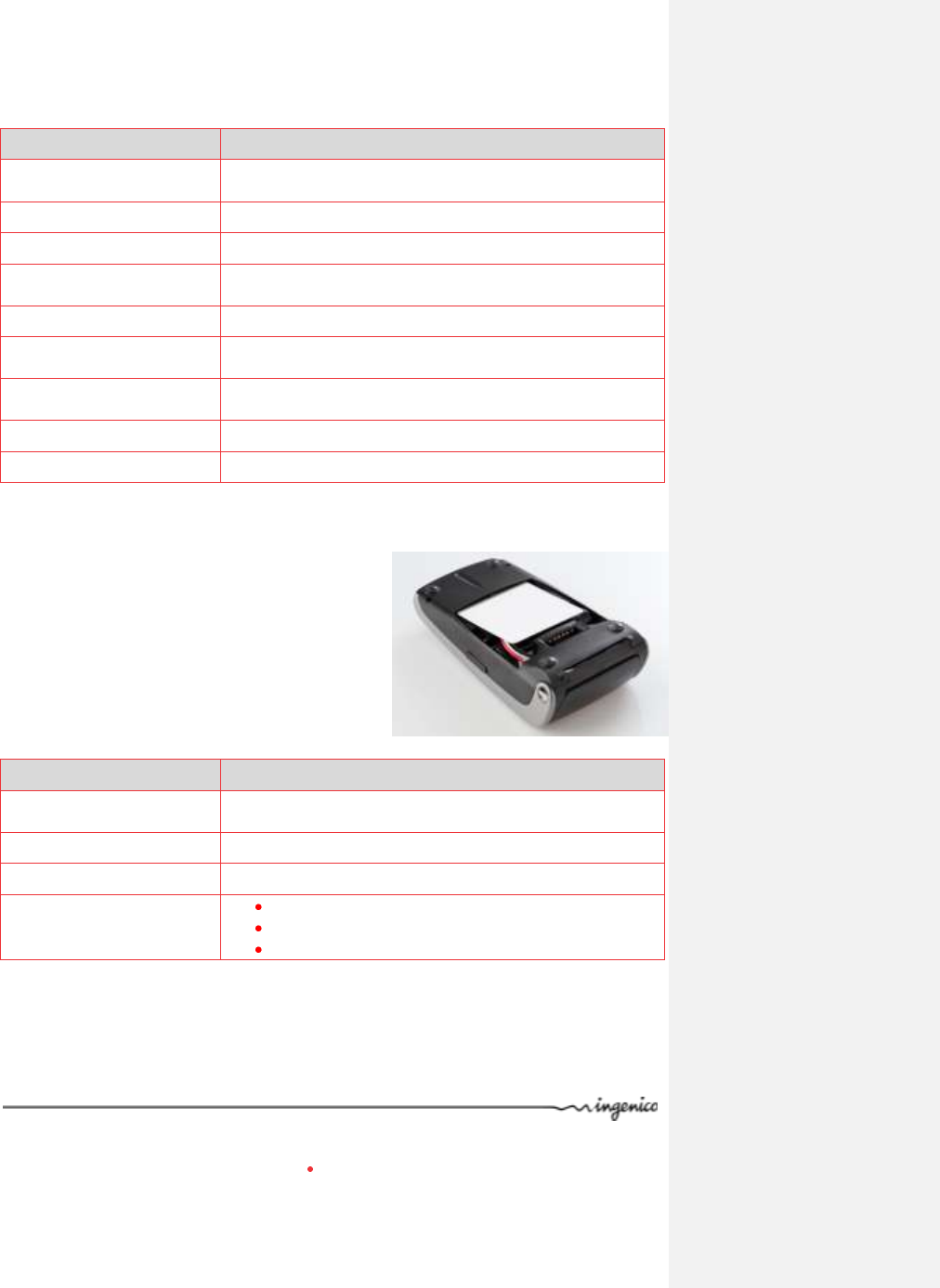
Technical manual _iWL220/250
ICO_MKP_009_GU_EN_V4
20/60
Copyright © 2010 Ingenico
All rights reserved
It can detect cards presence and resist to IK04 impact.
Feature
Description
Conformity with ISO
standard
- ISO/IEC 7816-1, 2, 3 standard
- EMV specifications
Protocol handled
Synchronous and Asynchronous T=0 & T= 1
Clock frequency
4,76MHz (double choice by SW, with PPS management)
Protection
Detection of short-circuit or over-consumption
Detection of accidental removal
Programming voltage Vpp
Not connected
Grip
8 friction contacts (middle chip)
Contact for card presence and removal
Synchronous cards
Separate logical outputs on contacts 4 and 8
Possibility of specific drivers development on request.
Power supply voltage
Vcc 5V or 3V or 1.8V (transition by software)
Read head lifespan
300 000 cycles
2.3.6.2. 2nd card reader
On the iWL2xx the second card reader is an optional
device. It is located at the rear side of the terminal.
The card is hidden under a removable trapdoor.
Featu
Description
Conformity with ISO
standard
ISO7816-2
Cards format
ID1 format
Synchronous cards
Don’t manage 4 and 8 contacts
Read head lifespan
Resist to foreign object insertion IP30
Resist to card insertion in a wrong way
Up to 5000 card operations (insertion /withdrawal)
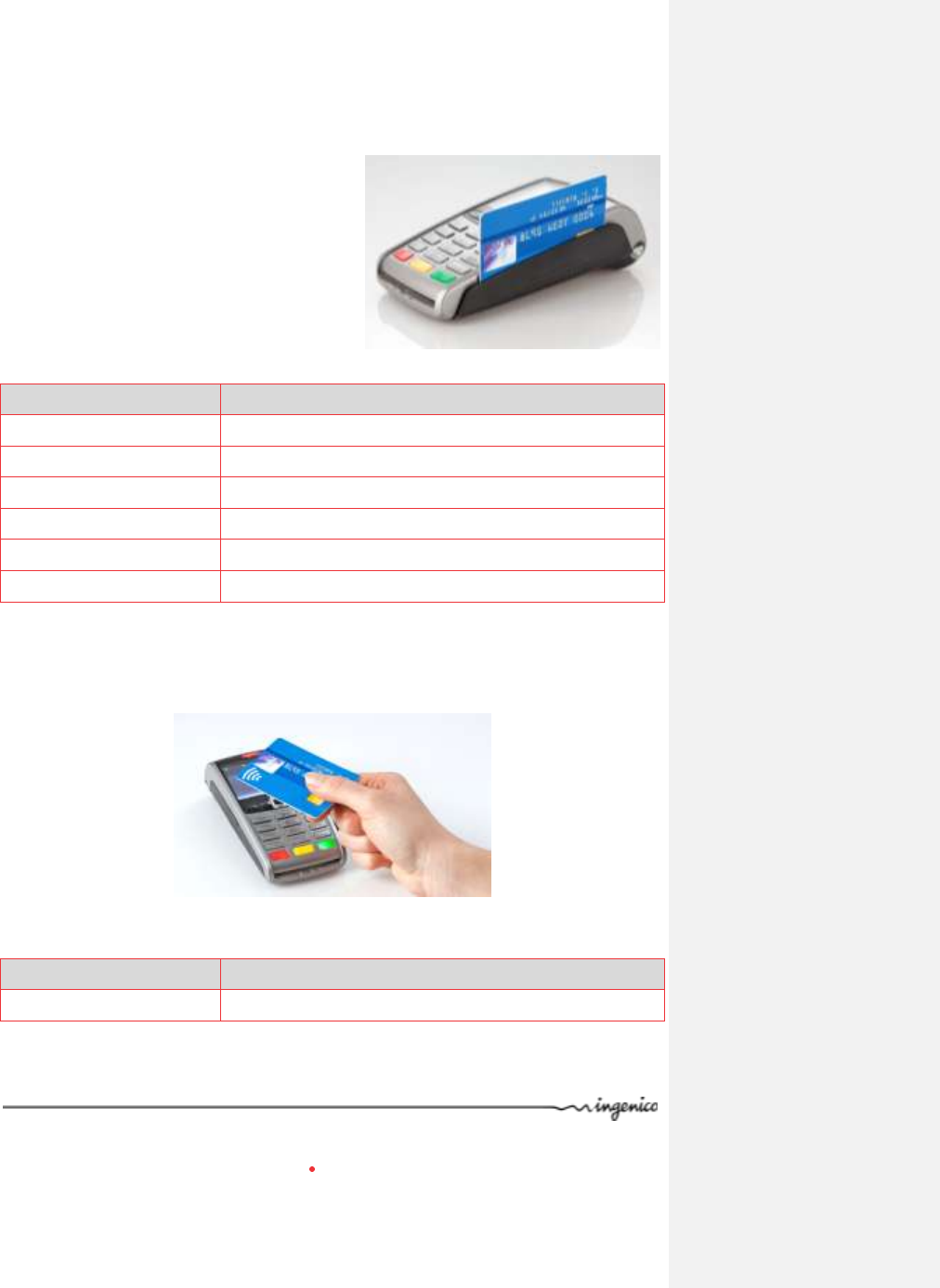
Technical manual _iWL220/250
ICO_MKP_009_GU_EN_V4
21/60
Copyright © 2010 Ingenico
All rights reserved
2.3.6.3. Magnetic stripe reader
The reader is located on the right side of the
terminal and a drawing indicates card position
and swiping direction.
The MSR is able to read the 3 tracks
simultaneously.
Feature
Description
Reader type
Manual
Tracks read
Tracks ISO 1, 2, 3
Cards format accepted
ISO7810 and 7811 and 7813 standards
Card swipe speed
From 0.1m/s to 1m/s with typical cards
Read direction
Bi-directional
Read head lifespan
500 000 reads
2.3.6.4. Contactless reader
The contactless reader is located around the display.
Feature
Description
Reader type
Contactless

Technical manual _iWL220/250
ICO_MKP_009_GU_EN_V4
22/60
Copyright © 2010 Ingenico
All rights reserved
Cards format accepted
ISO/IEC 14443-2
Type A&B standard
EMV specifications
Mifare:
Mifare classic 1k / classic 4k
Mifare mini
Mifare Ultralight /Ultralight C
“Ultralight C” managed as “Ultralight” (DES
authentication not implemented)
Mifare DESFire 2k/4k/8k
Mifare Smart MX (Type A)
ISO 14443 Type B
NFC Master , passive mode
Felica (scheduled for 2011)
Calypso
Information processing
4 indicator lights
Communication speed
106 / 212 kb/s
Operating volume
Up to 4 cm
Optional
Yes (factory setting)
2.3.6.4.1. Introduction to Contactless
“Contactless” is the term that was invented and widely adopted by the Smartcard industry
to characterize a new way to read smartcards. By using radio signal, it is possible to read
cards at a short distance, without inserting a card in the reader, thus the name
“contactless”.
Contactless technology is sometimes mixed with Radio Frequency Identification (RFID),
which is partly true since both use the same principles: a reader (sometimes called a
coupler) sends a radio frequency (RF) wave through a card or a tag containing a coil and a
small chip RF power energizes the coil, giving enough current to power the chip and allows
data transmission both way.
It should be noted however that RFID is mostly used for identification of objects and
animals, and is based on a wide range of frequencies (from 125 kHz to 5 GHz). On the
contrary, contactless allows the use of microprocessor smartcards with more security and is
preferred for the identification of persons (for ID, payment and others uses). Contactless
uses only one frequency: 13.56 MHz.

Technical manual _iWL220/250
ICO_MKP_009_GU_EN_V4
23/60
Copyright © 2010 Ingenico
All rights reserved
2.3.6.4.2. What is Contactless card payment?
The contact payment allows a cardholder to make a purchase without having
to hang over, swipe or dip a payment card. To make payment the cardholder
simply present the payment card in front of the contactless landing zone of
the terminal, defined by the logo:
A payment contactless will normally be an offline authorized chip transaction, the card can
be removed 500 milliseconds (ms) and the transaction will be completed in less than one
second.
In certain local markets and for international may be required after the card has been
removed.
2.3.6.4.3. The advantages of Contactless technology
Contactless technology offers several advantages:
Short transaction time: the ease of card to reader presentation and a high speed of
data transfer reduce considerably the transaction time. Because the transaction
time is reduced, business can increase speed and generate more revenue.
Reliability and lower costs: there is no mechanical contact between the card and the
reader so the damages of both card and reader are reduced. Thus, contactless
technology is reliable and reduces the maintenance cost of reader.
Vandal protection: Contactless technology increases protection against vandalism.
Whereas the contact slot of contact reader is often the target of vandalism acts,
contactless reader will not exposed to these problems.
Security: The use of contactless smart cards with a microprocessor allows for a high
level of transaction security and these cards are very difficult to duplicate.
2.3.6.5. SAM readers
The access to the SAMs is protected. It is located under a removable trap.
SAMs are identified by marking on casing “1” and “2”.
An optional third SAM is available. A SAM3 label identifies this option on the right of the
reader.
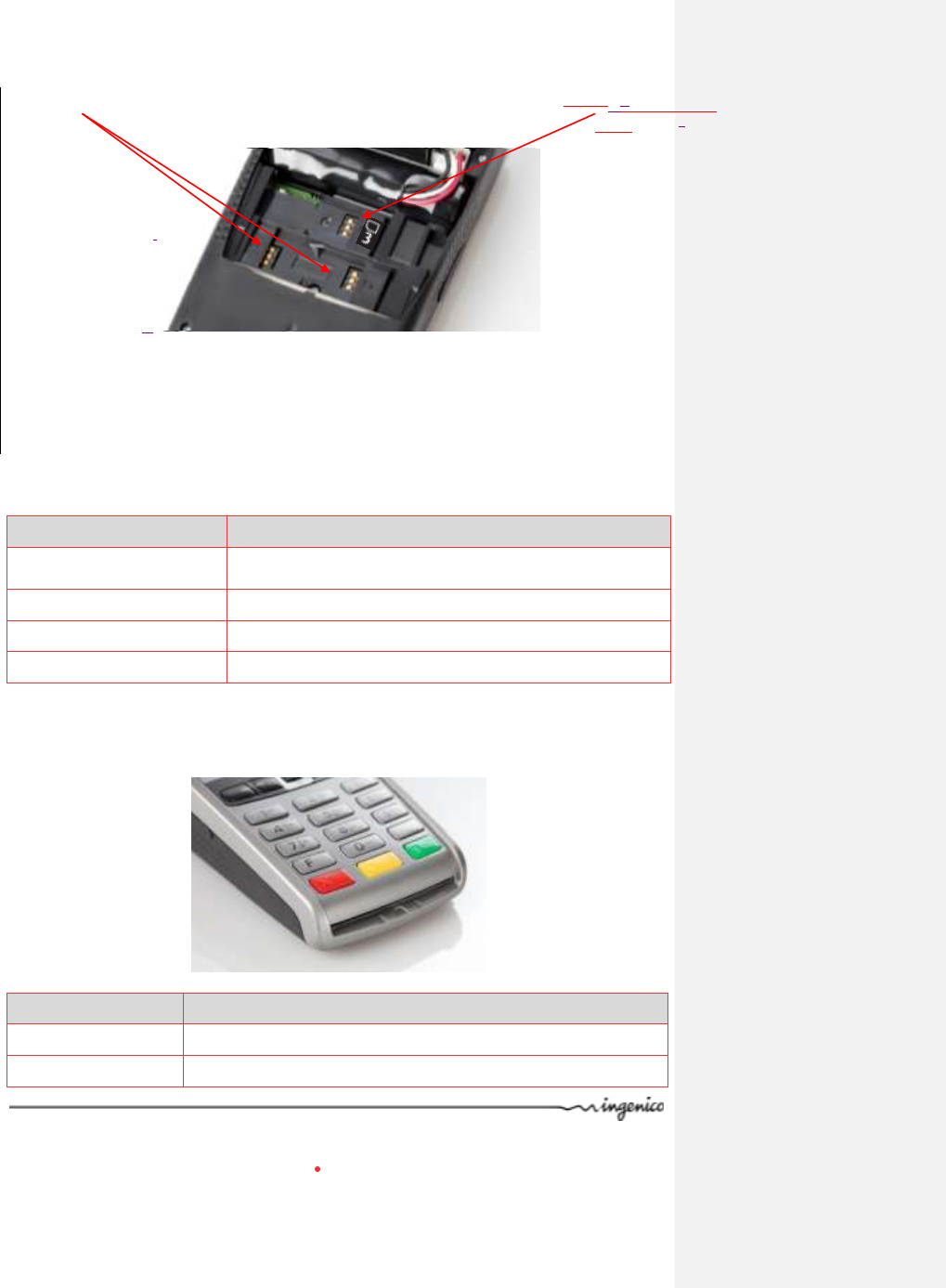
Technical manual _iWL220/250
ICO_MKP_009_GU_EN_V4
24/60
Copyright © 2010 Ingenico
All rights reserved
Feature
Description
Conformity with ISO
standard
ISO7810
Cards format
ID-000 format
Synchronous cards
Don’t manage 4 and 8 contacts
Lifespan
1000 SAM operations (insertion/withdrawal)
2.3.7. Keypad , navigation pad
Feature
Description
Number of keys
15+ up/down/OK navigation keys+ 4 function keys F1-F2-F3-F4
Type
Elastomer membrane
2 SAM
readers
2 SAMOoptional third
SAM readers
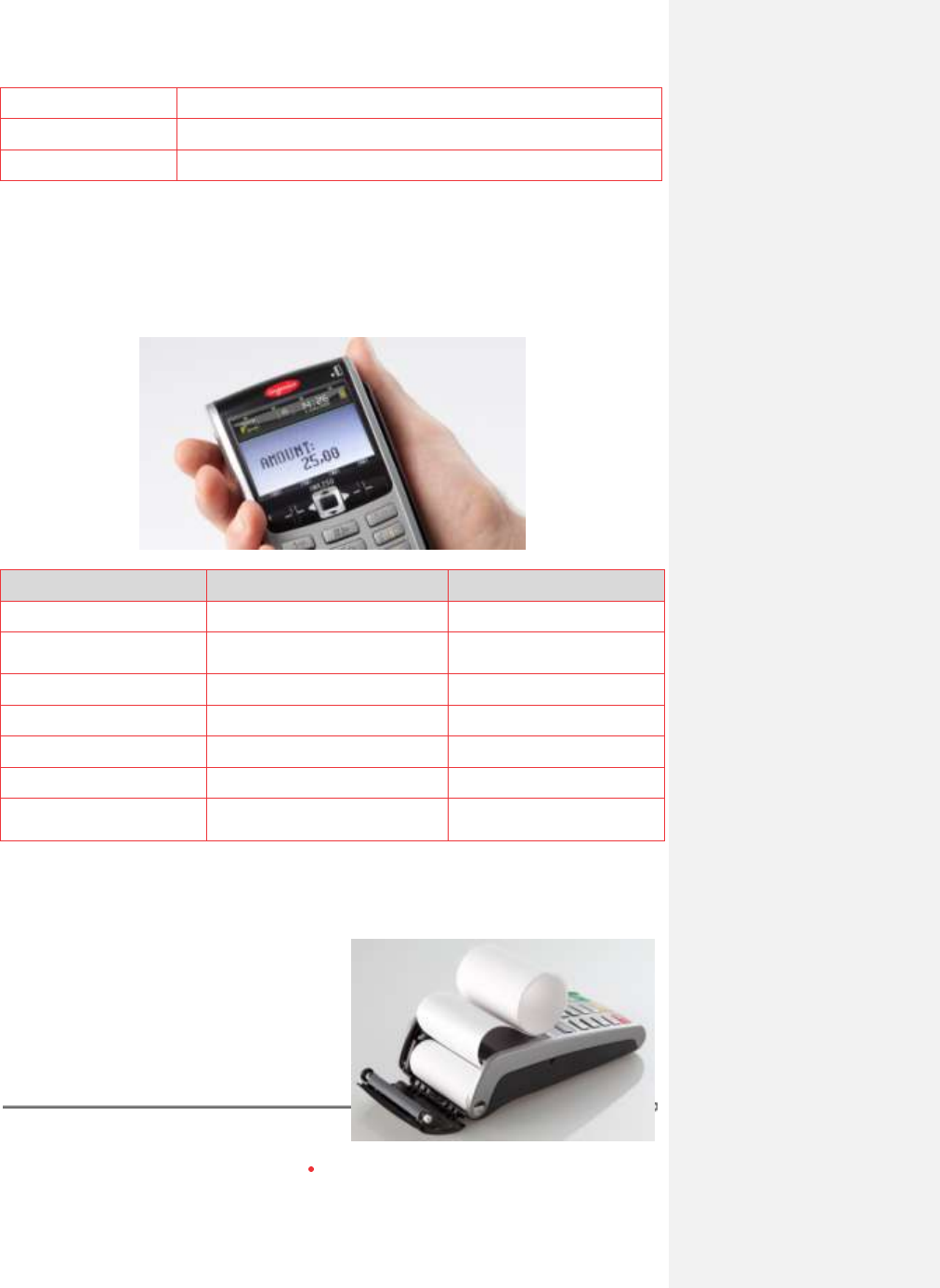
Technical manual _iWL220/250
ICO_MKP_009_GU_EN_V4
25/60
Copyright © 2010 Ingenico
All rights reserved
Number of operations
2 000 000 operations
Pressing force
80g to 200g
Backlit
White by LED
2.3.8. Display
Feature
iWL220
iWL250
Type
Monochrome
Color
Display area
2.53”
56,3 x 31,3 mm
2.81”
57,1 x 42,8 mm
Number of pixels
128 x64
320 x 240 (QVGA)
Technology
FSTN
TFT
Frame frequency
40Hz
70Hz
Number of colors
NA
4096 colors
Serviceability
Screen replaceable in repair
center only
Screen replaceable in repair
center only
2.3.9. Printer
iWL2xx printer allows a fast printing: up to 30
lines/s. It is very silent: ≤52dB.
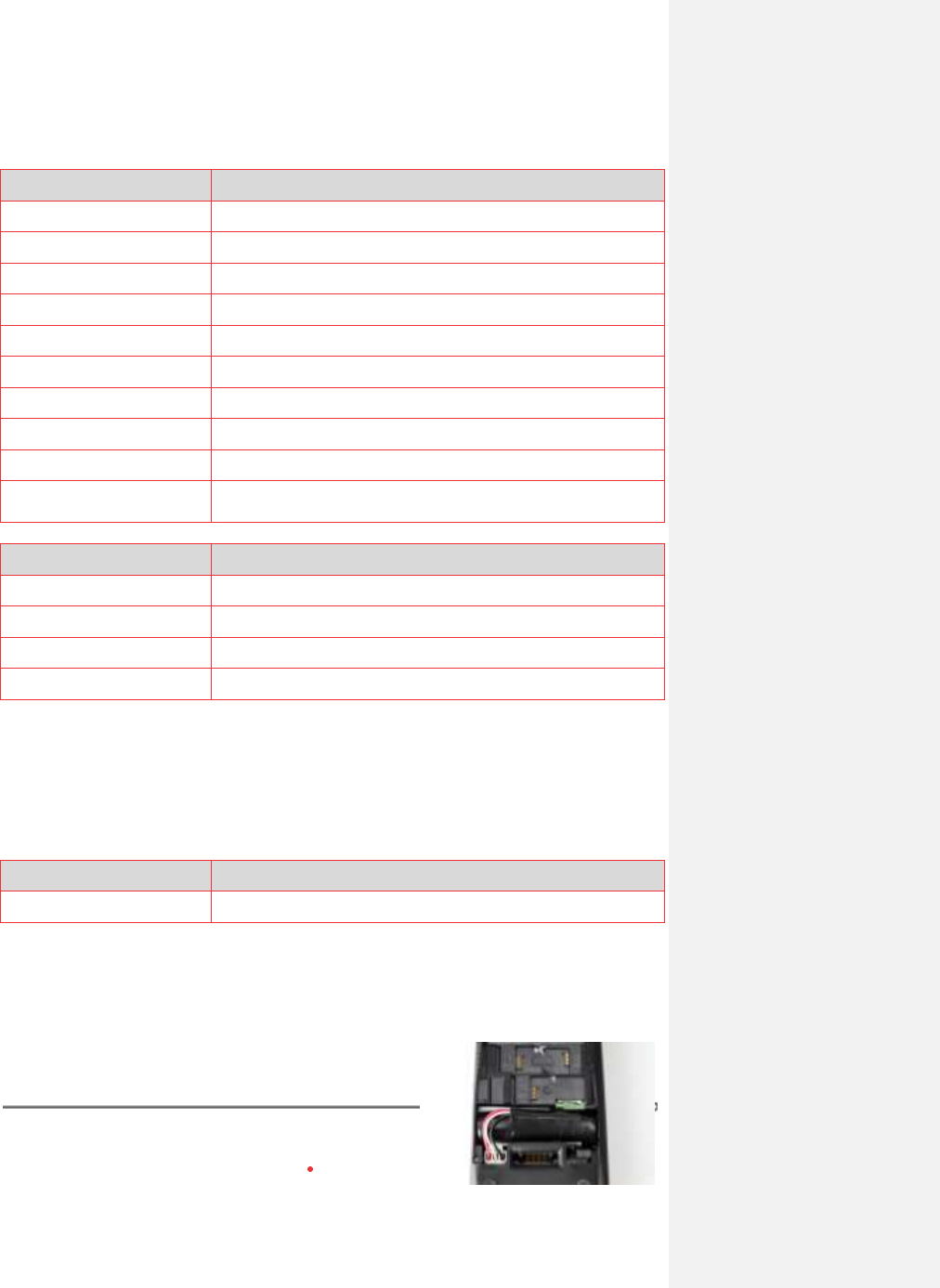
Technical manual _iWL220/250
ICO_MKP_009_GU_EN_V4
26/60
Copyright © 2010 Ingenico
All rights reserved
Feature
Printer’s description
Type
Thermal printing
Paper loading
Easy paper loading without paper axis
Printing speed
Up to 30 lines/s – 90mm/s
Noice level
≤52dB
Paper presence detection
Paper sensor at the end of the roll
Definition
200 DPI
Lifespan
200 000 transactions , 400 000 cuts with reference paper
Graphic mode
200 DPI in two directions
Printing color
Black
MTBF
Printer Annual Failure Rate for printer estimation : 2% (printer
MTBF : 50 years estimated)
Feature
Paper roll’s description
Paper type
Paper color White – JUJO AF50ks or equivalent
Width
56 mm
Length
9 m (for 25 mm diameter roll), around 17 m (for other rolls)
Diameter
25 mm / 40 mm
2.3.10. Audio
2 modes available:
- buzzer
Feature
Buzzer’s description
Noise level
Up to 60 dB, at 1 m all directions (adjustable by software)
- audio speaker (option for iWL250)
2.3.11. Battery

Technical manual _iWL220/250
ICO_MKP_009_GU_EN_V4
27/60
Copyright © 2010 Ingenico
All rights reserved
The iWL2xx has a lithium-ion easy-to-set-and-remove battery.
Feature
Description
Type
Lithium-ion
Power
2050 mAh
Battery life
- 1 000 transactions with fully charged battery and without
energy consumption related to backlit or radio link
- Can remain powered ON up to 300 hours in sleeping state
starting with fully charged battery and without energy
consumption related to backlit or radio link
- Can remain powered ON up to 200 hours with connected
GPRS/3G link and terminal in sleeping state starting with fully
charged battery and without energy consumption related to
backlit or radio link
Saving power mode
Automatic sleeping mode and backlight power off (time can
be user defined)
Charge
With 5V-1A power supply
Recharge time
4 hours from empty to full charge
Powering mode
- Putting the terminal on the base
- Directly connecting the micro USB port
MTBF
According to battery supplier : 80% of the initial capacity (i.e.
1700 mAh) still available after 500 charging cycles, under
nominal conditions.
Back-up battery
Lithium cell 3V-220mAH
Please note that these data are approximate.
2.3.12. Power supply unit
Two main types of PSU are offered:
Multi PSU with adapter for different countries (Australia, UK…) allowing either to
deliver a solution compatible with several standards or to provide a solution for
countries not covered by CE, UK or US standards
Monoplug PSU CE or US or UK type
Character
Description
Input voltage
100-240V , 50/60 Hz
Output voltage
5V, 1A

Technical manual _iWL220/250
ICO_MKP_009_GU_EN_V4
28/60
Copyright © 2010 Ingenico
All rights reserved
Protection
Against surges: thermal fuse placed on primary
Against conducted interference: integral filter
Standards
Class II double-isolation
Mechanical Interface
Power supply jack with safety catch
Straight flexible cable: about 3 meters long between base
and power supply unit , plug in on base side
Weight
Approximately 100 g
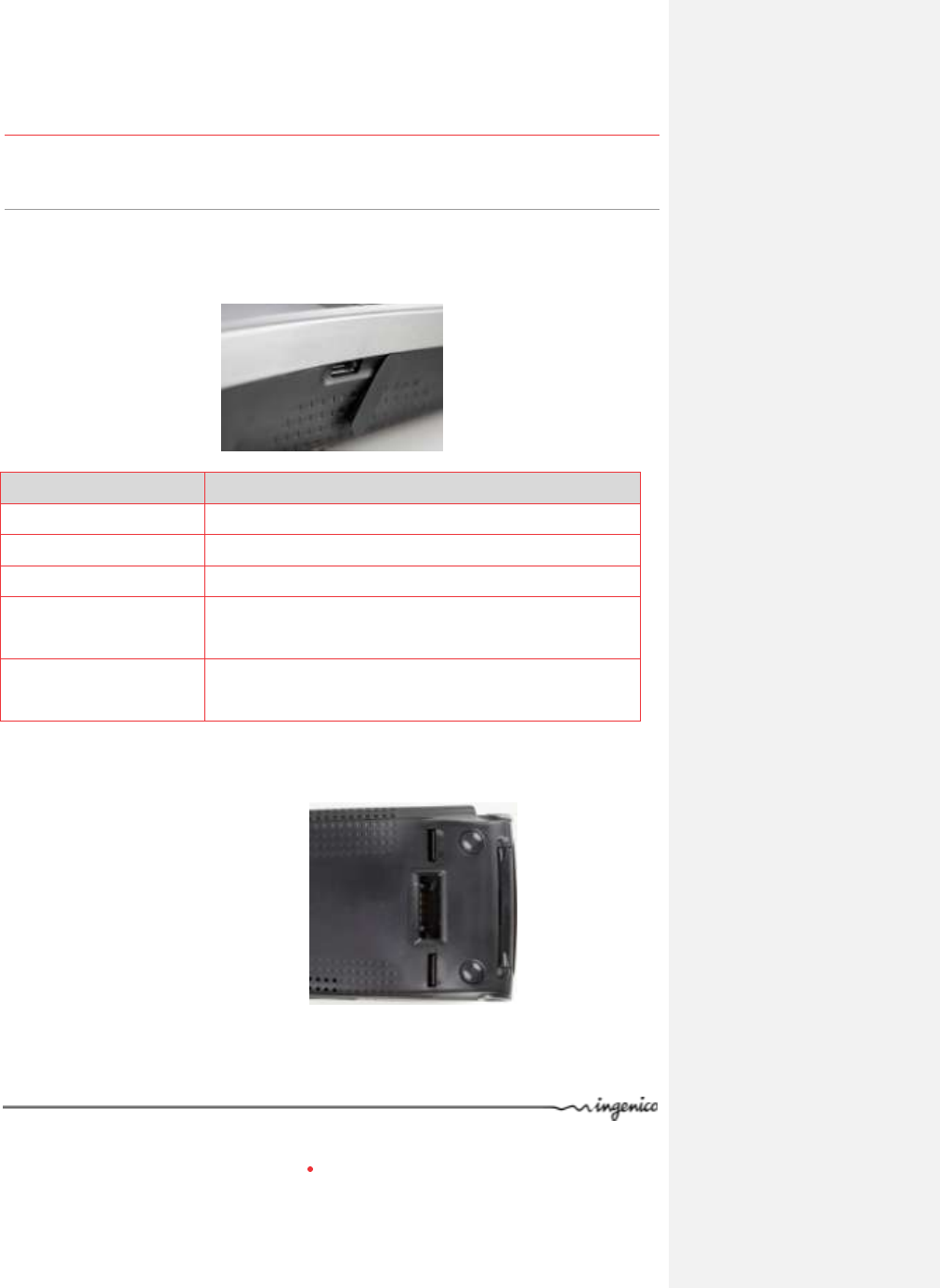
Technical manual _iWL220/250
ICO_MKP_009_GU_EN_V4
29/60
Copyright © 2010 Ingenico
All rights reserved
3. Connectivity
3.1. On terminal
3.1.1. Wired Connectivity:
3.1.1.1. micro USB type A/B
Characteristic
Micro USB type A / B
Electronic interface
USB Host & Slave
Life duration
Up to 1000 operations
Mechanical interface
A-B micro-USB receptacle
Logical interface
Low speed: 1.5 Mbps
Full speed: 12 Mbps
USB2.0
Functionnalities
- Battery recharge
- Software upgrade
- Terminal to be used as a USB device
3.1.1.2. Base Interface
The iWL2xx has a connection interface
allowing to create a USB link between
the Terminal (HOST) and the base
(SLAVE).
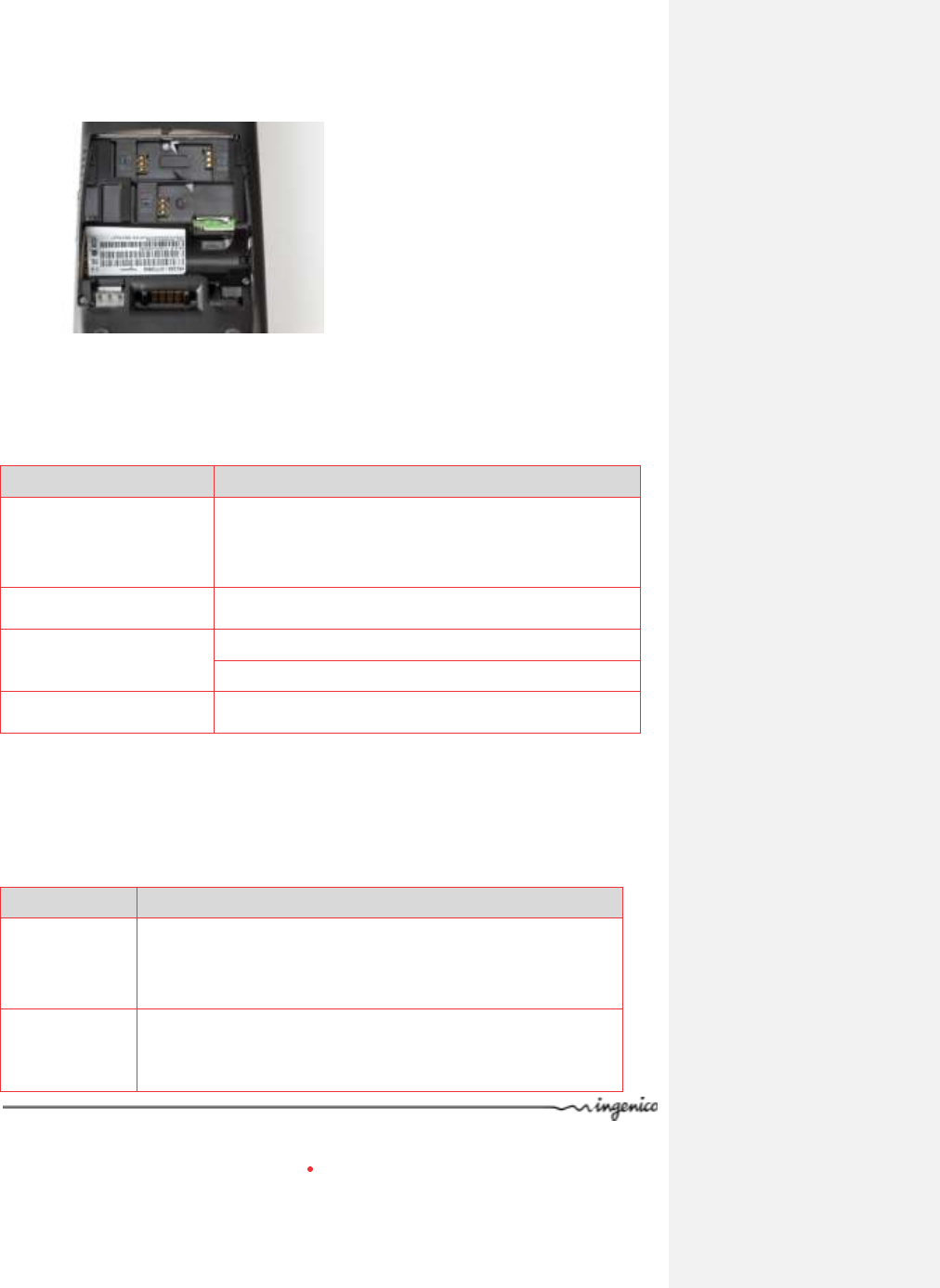
Technical manual _iWL220/250
ICO_MKP_009_GU_EN_V4
30/60
Copyright © 2010 Ingenico
All rights reserved
3.1.2. Wireless Connectivity
3.1.2.1. GPRS
The GPRS connection is optional in iWL2xx.
The access to the GPRS SIM connector is protected; it is located under a removable trap.
GPRS SIM is identified by marking on casing “SIM”.
Characteristics
GSM/ GPRS
Frequency
Quad band:
GSM (850, 900Mhz)
DCS (1800Mhz)
PCS (1900Mhz)
Transit power
Class 4 (2W) for GSM850 / EGSM900
Class 1 (1W) for DCS1800 / PCS1900
Communication feature
Multi slot Class 10 ( 4+1, 3+2)
Stay connect feature
GPRS baudrates
Downlink up to 85.6 kbps,
Uplink up to 42.8 kbps
3.1.2.2. 3G - HSDPA
The 3G-HSDPA connectivity is one of the connectivity options available for iWL250.
The access to the 3G SIM connector is protected; it is located under a removable trap.
The 3G SIM is identified by marking on casing “SIM”. It is the same slot than the GPRS SIM.
Characteristics
HSDPA 3,6Mbps and EDGE/GPRS/GSM Class 12
Frequency
Triple bands WCDMA 900/1900/2100 MHz or 850/1900/2100 MHz
Full Quad band support GSM/GPRS/EDGE 850/900/1800/1900 MHz
Transmit power
Class 4 (2W) for GSM850 / EGSM900
Class 1 (1W) for DCS1800 / PCS1900
Class E2 EDGE 900 / 1800
Class 3 for UMTS 900/1900/2100
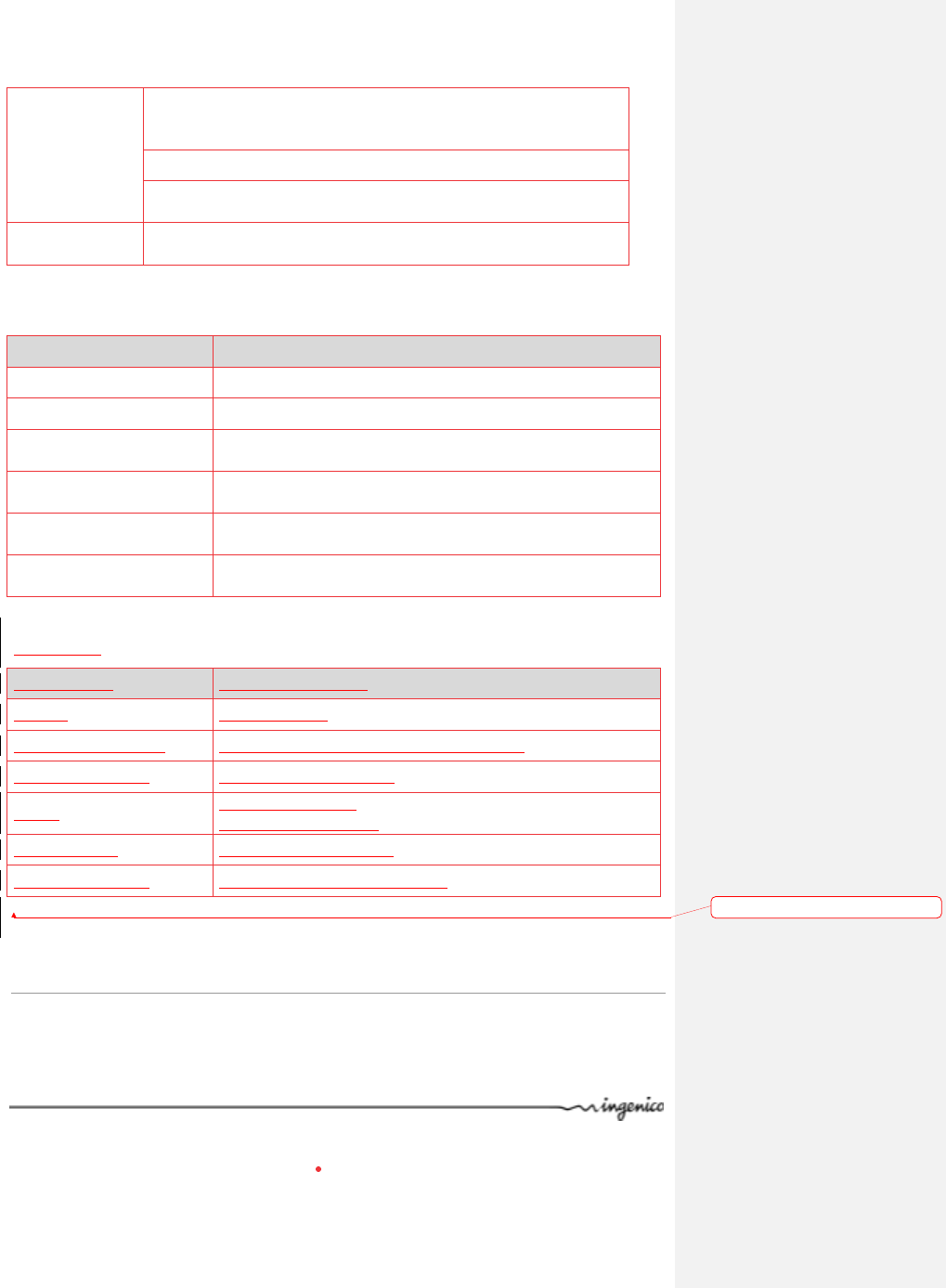
Technical manual _iWL220/250
ICO_MKP_009_GU_EN_V4
31/60
Copyright © 2010 Ingenico
All rights reserved
Com. feature
GPRS SMG 31bis, Multi slot class 12, class B terminal, PBCCH
support, 3
PDP contexts, CS1 to CS4.
EDGE Multi slot class 12
Class E2, Voice and Data in parallel for UMTS/HSDPA, 4 logical
channels
HSDPA baudrate
Downlink up to 3.6 Mbit/s
Uplink up t 0.384 Mbit/s
3.1.2.3. Bluetooth
Characteristic
Bluetooth V2.0
Chipset
Bluecore 6
Standard compliance
Bluetooth v2.1 EDR (enhanced data rate) – Class 1
Profile
SPP
Other profile to be analysed on request
Radio transfer rate
1 Mbit/s
2Mbit/s (EDR)
Number of supported
links
7 slaves to 1 base
Range
Indoor: 70m typical
Bluetooth Class 1 – mini 100m in free sight
3.1.2.4. Wifi
Characteristic
2.4Ghz and 5Ghz wifi
Chipset
TI wilink 8 base
Standard compliance
802.11 a,b,g,n / SISO / 20-40MHz bandwidth
Radio transfer rate
From 1 Mbit/s to 135Mb/s
Range
Indoor: 30m typical
mini 100m in free sight
Home security
OPEN, WEP, WPA, WPA2
Enterprise security
EAP-TLS, EAP-TTLS, EAP-PEAPv0
3.2. On base
Mis en forme : Anglais (États Unis)
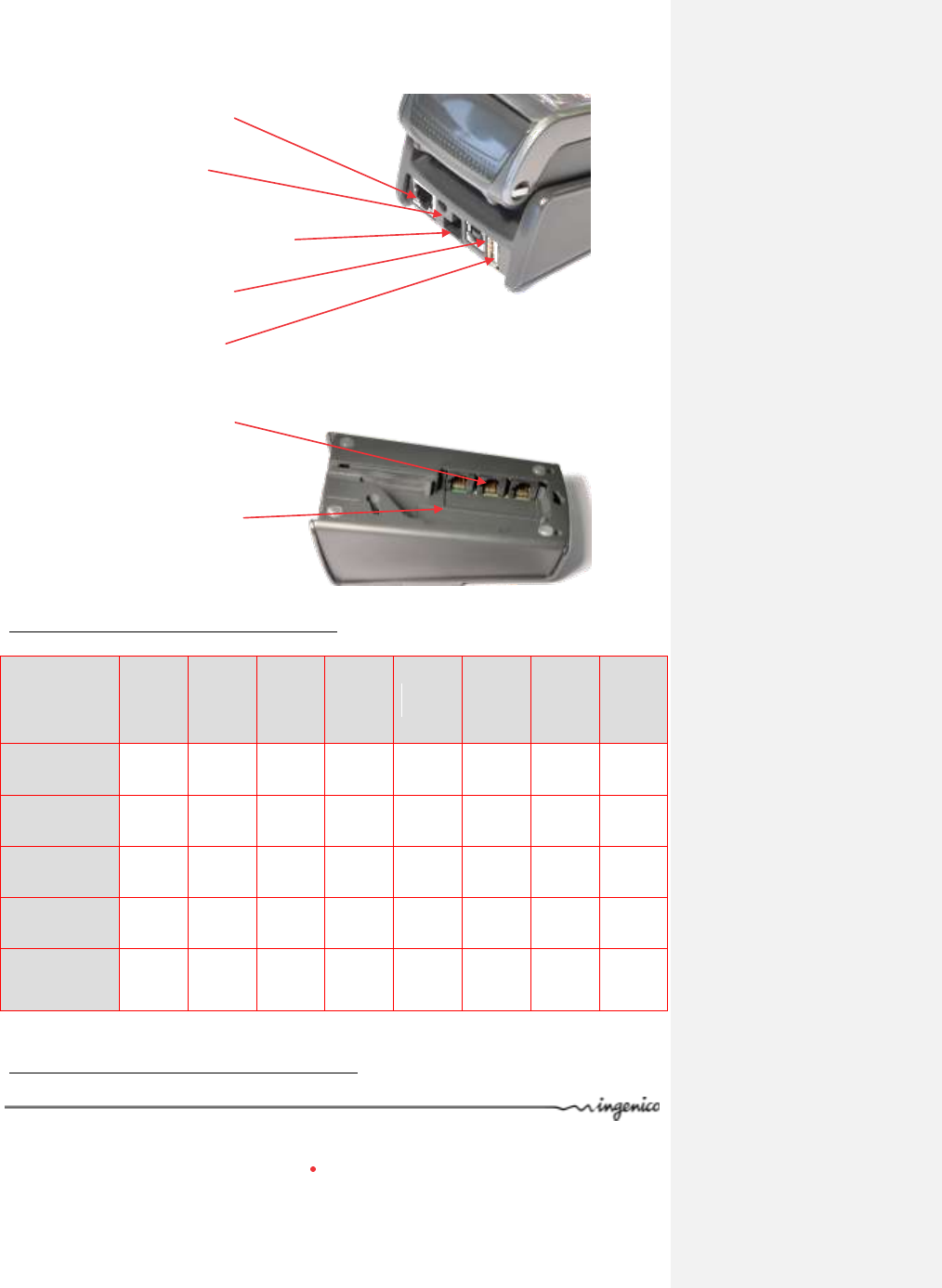
Technical manual _iWL220/250
ICO_MKP_009_GU_EN_V4
32/60
Copyright © 2010 Ingenico
All rights reserved
Terminal bases available for the iWL2xx series:
Base’s name
Power
supply
Line
in
1 USB
Host
1 USB
Slave
1 x
RS232
2 x
RS232
Ethernet
Power
Over
Ethernet
(POE)
Charger Base
●
Modem- 1RS
Base
●
●
●
●
Modem- 2RS
base
●
●
●
●
Ethernet
Modem- Base
●
●
●
●
●
(●)
Bluetooth -
Ethernet-
Modem Base
●
●
●
●
●
●
(●)
(x): optional feature
Brief technical descriptions of the base’s options:
Ethernet Port
Power Jack
Cable management
USB B (Slave)
USB A (Host)
Modem & RS232
ports
Cable
Management cage
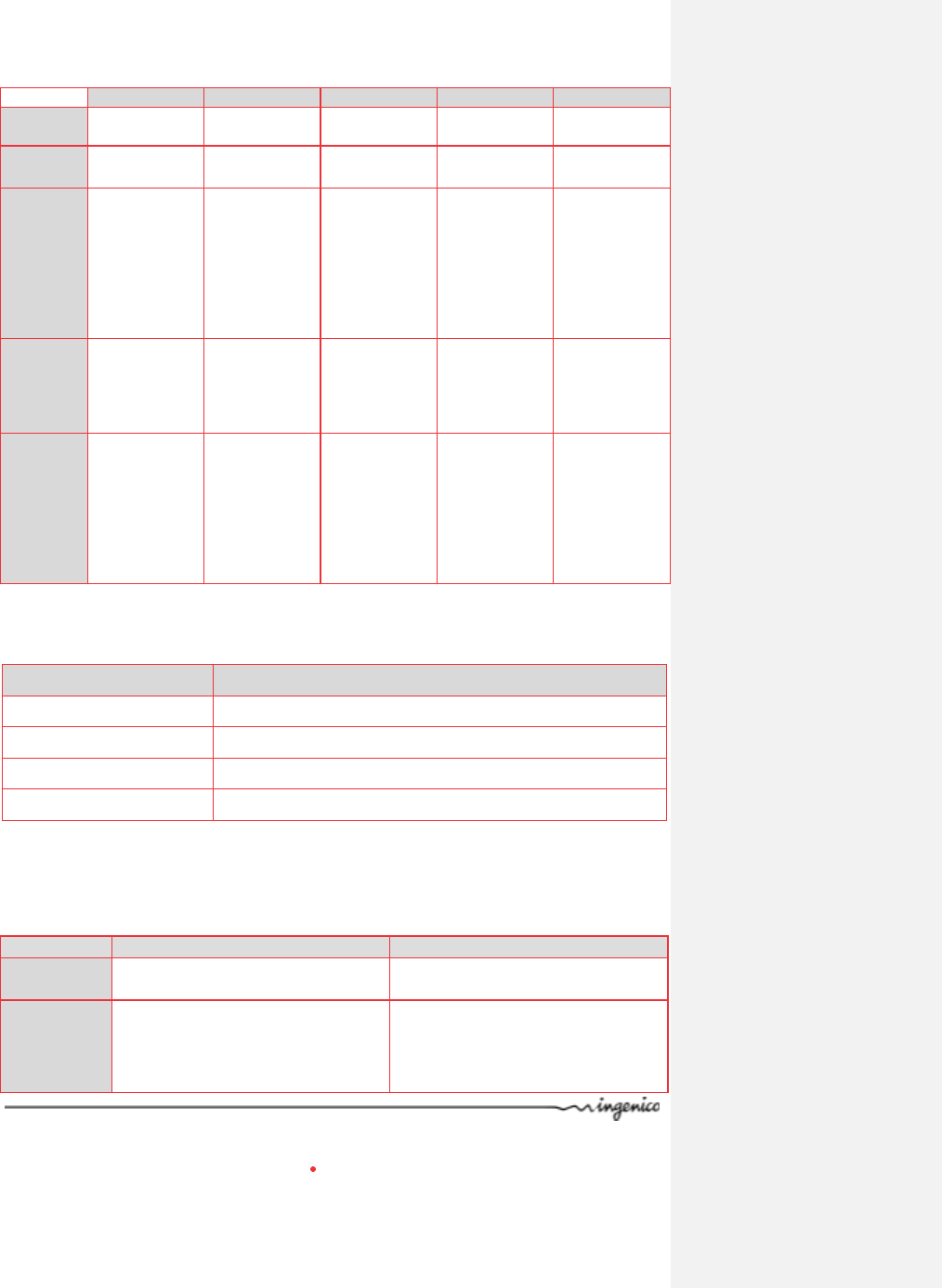
Technical manual _iWL220/250
ICO_MKP_009_GU_EN_V4
33/60
Copyright © 2010 Ingenico
All rights reserved
Modem
COM0 or COM1
Host USB
Slave USB
Ethernet
Electronic
interface
Simplified
RS232
Host USB
Slave USB
IEEE 802.3
Number of
wires
CTS RX TX GND
RTS
5v-D+ GND
5v-D+ GND
RX+ RX-
TX+ TX-
Mechanical
interface
V34, V32b,
V32,V42,V42b,
MNP4&MNP5
V22b, V22, full
duplex,
asynchronous,
synchronous
Modular jack 6
points
RJ11
1=Ground
3=Rx
4=Tx
5=CTS
6= RTS
Type USB
socket
1=5V
2=D-
3=D+
4=GND
Modular jack
8 points RJ 45
Standard
interface
Logical
interface
Operation
from 0 to -
43dBm
Software
configured
300-115kbps
Software –
configured
framing
Low speed: 1.5
Mbps
High speed:
480 Mbps
USB 2
12Mbps max
USB 1.1
10 Mbps and
100 Mbps
compatible
Full duplex
Connection
examples
AT compatible
Connection to
network by
RJ11
Cash register
Check
editor/reader
Computer
External
modem
RS 485
converter unit
Check-reader
External-
modem dongle
External ISDN
dongle, …
POS
integration
LAN
3.2.1. Base charger
Characteristic
Endurance
300 000 dockings with the terminal supported
Type
110-230 V +/- 10%, 50-60 Hz
Insulation
Class II
Charge
With 5V-1A power supply
The connector is a power supply jack.
3.2.2. USB
USB Host A
USB Slave B
Electronic
interface
USB HOST
USB slave
Number of
wires
1= vBus
2= D–
3= D+
4= GND
1= vBus Slave
2= D –
3= D+
4= GND
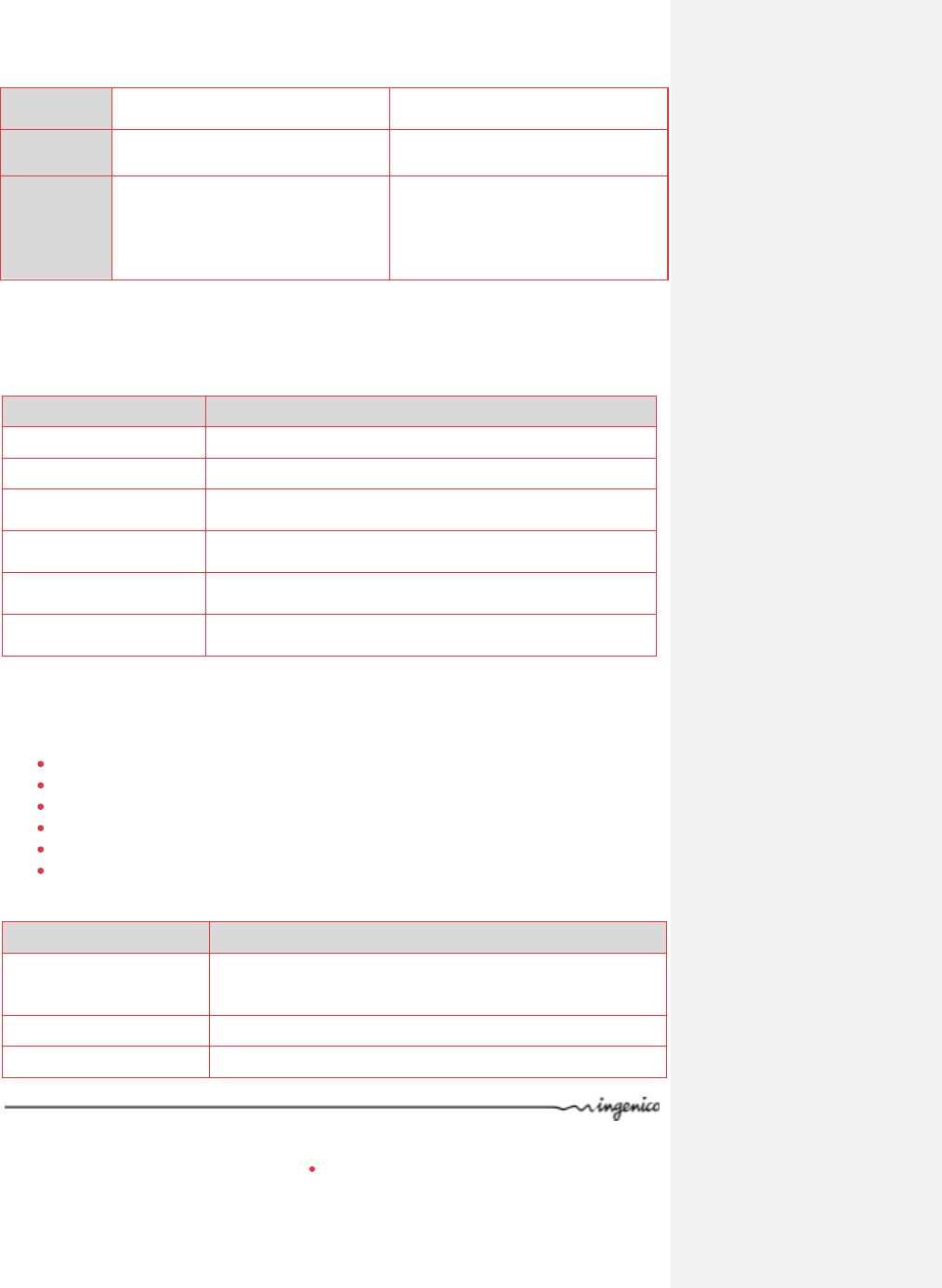
Technical manual _iWL220/250
ICO_MKP_009_GU_EN_V4
34/60
Copyright © 2010 Ingenico
All rights reserved
Mechanical
interface
USB type A jack
USB type B jack
Logical
interface
Low speed : 1,5 Mbps
High speed : 12 Mbps
CDC Class only
Connection
examples
- Check reader equipped with USB
- PP30S, P30
- Fingerprint sensor
- Contactless target, external
modem, …
- Local downloading tool
- Point of sale integration
3.2.3. Bluetooth
Characteristic
Bluetooth V2.0
Chipset
Bluecore 6
Standard compliance
Bluetooth v2.1 EDR (enhanced data rate) – Class 1
Profile
SPP
Other profile to be analysed on request
Radio transfer rate
1 Mbit/s
2Mbit/s (EDR)
Number of supported
links
7 slaves to 1 base
Range
Indoor: 70m typical
Open space: up to 250m
3.2.4. Modem (PSTN)
Modem V22, V22b , V32, V32b ( respectively 1 200, 2 400, 9 600, 14400 bauds)
Full software configuration
AT compatible
Communicates with the STN
Responder, initiator, busy line detection
Fast connect
Characteristic
PSTN
Modulation / Compression
V34, V32b, V32,V42, V42b, MNP4& MNP5
V22b, V22, full duplex,
asynchronous, synchronous
Emission levels
Software configured – 0 to 15dBm
Reception levels
Operation from 0 to -43dBm

Technical manual _iWL220/250
ICO_MKP_009_GU_EN_V4
35/60
Copyright © 2010 Ingenico
All rights reserved
Insulation
Line differential security: 250V non-destructive
Galvanic isolation between line interface and modem: 2.500
volts/1min
Logical
AT-compatible command set
Cable
Plug-in cable, length 3m, fitted with RJ11 at both ends
Connection to network by RJ11 socket + T/RJ11 adapter if
necessary
3.2.5. Ethernet
Characteristics
Ethernet
Electronic interface
IEEE 802.3
Number of wires
RX+ RX-
TX+ TX-
Mechanical interface
Modular jack 8 points RJ 45
Standard interface
Logical interface
10 Mbps and 100 Mbps compatible
Full duplex
Speeds
100 MHz
Protocol
- IPv4
- FTP SSLv3 (Open SSL layer embedded. Security profiles
management. Single / dual authentication possible.
Conforms to Mastercard PTS program)
SNMP
SMTP
Connections examples
LAN
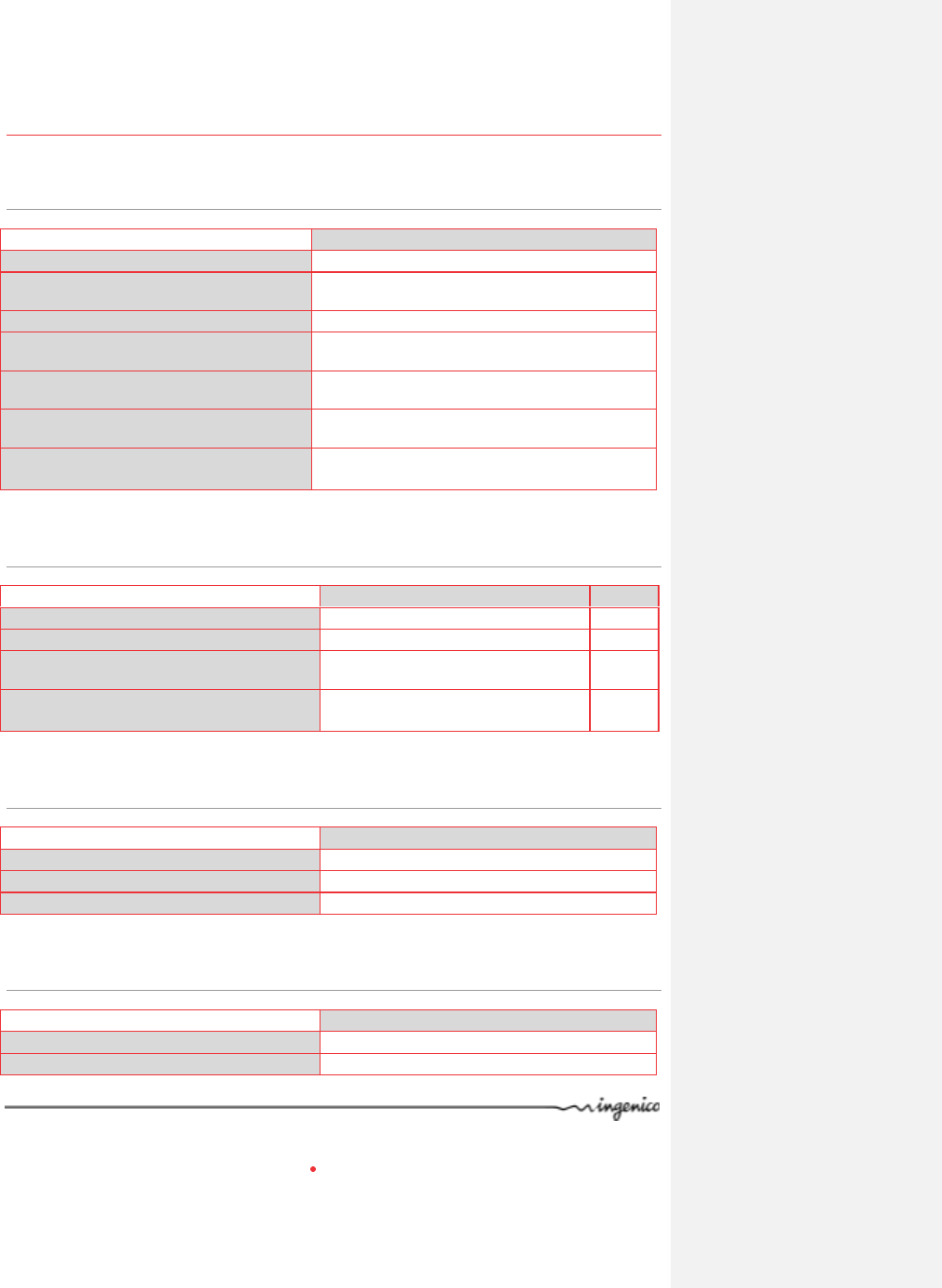
Technical manual _iWL220/250
ICO_MKP_009_GU_EN_V4
37/60
Copyright © 2010 Ingenico
All rights reserved
4. Standards
4.1. Immunity characteristics
Tests of immunity to:
Standards
Electrostatic discharges
IEC/EN 61000-4-2
Radio-frequency electromagnetic fields
EN 61000-4-3
(2002 + A1/2002)
Electrical fast transients/bursts
IEC/EN 61000-4-4
Surges
EN 61000-4-5
(2005)
Radio disturbances
EN 61000-4-6
(2003+A1/2004+A2/2006)
Magnetic fields
EN 61000-4-8
(1993+A1/2000)
Voltage dips, short interruptions and
voltage variations
EN 61000-4-11
(2004)
4.2. Disturbance produced by the equipment
Standards
Details
Conducted disturbance
EN 55022 éd. 1998 / A1-2000 / A2-2003
Class B
Radiated disturbance
EN 55022 éd. 1998 / A1-2000 / A2-2003
Class B
Limits for harmonic current emissions
EN 61000-3-2
(2000+A2/2005)
Limitation of voltage fluctuations and
flicker
EN 61000-3-3
(1994+A1/2001)
4.3. Operating conditions
Details
Operating Temperature
-10°C to +45°C
Charging temperature
+5°C to +40°C
Max relative humidity (no condensation)
85%HR at +40°C
4.4. Storage conditions
Details
Temperature
-20°C - +55°C
Max relative humidity (no condensation)
85% HR +40°C
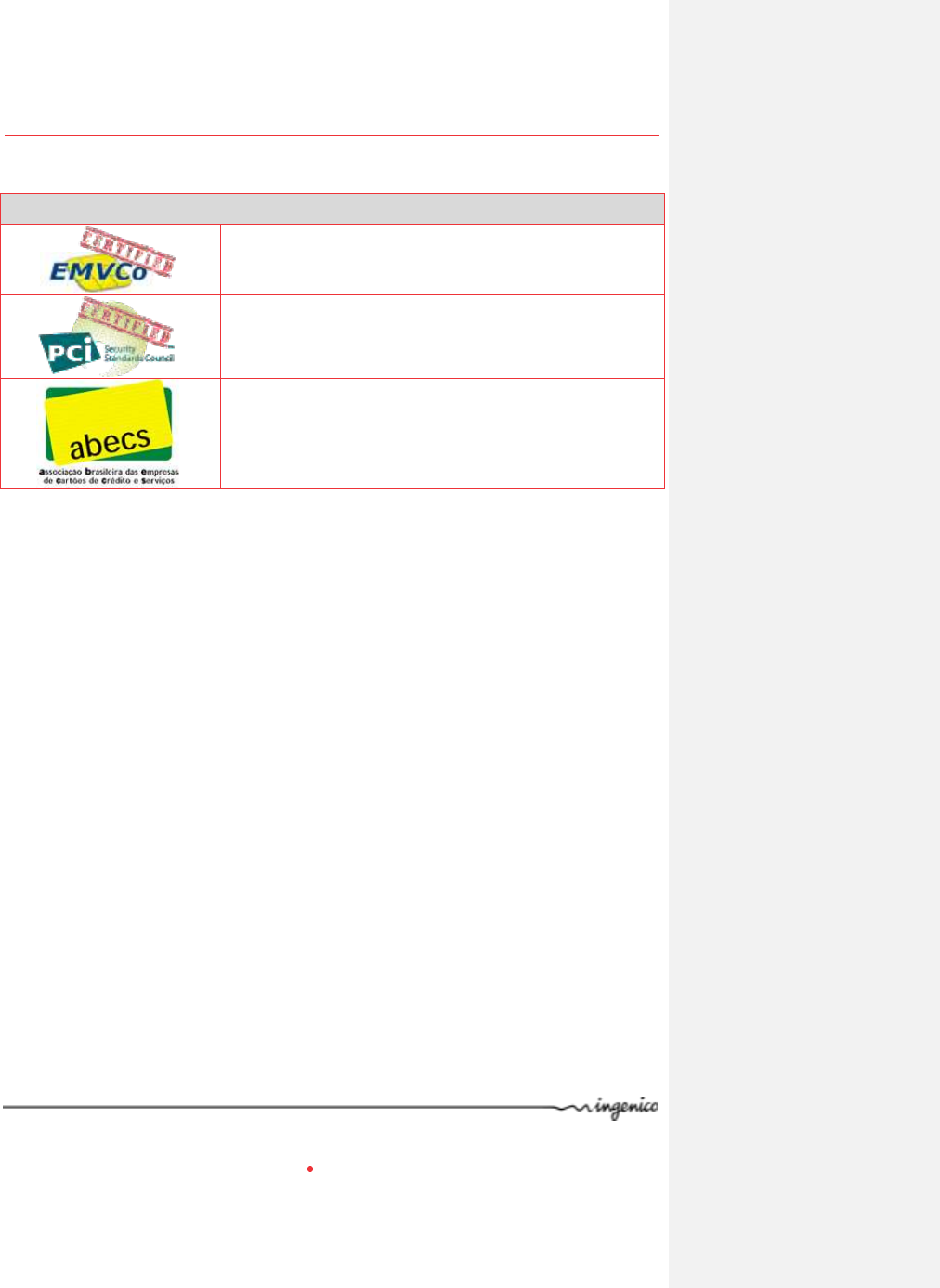
Technical manual _iWL220/250
ICO_MKP_009_GU_EN_V4
39/60
Copyright © 2010 Ingenico
All rights reserved
5. Norms and certifications
Certifications
Approved
LOA 124350910400 21 FIM, 9/6/2010
Approved v.2
LOA 4-20161, 9/27/2010
Approved
Manual ABECS Rev. 5
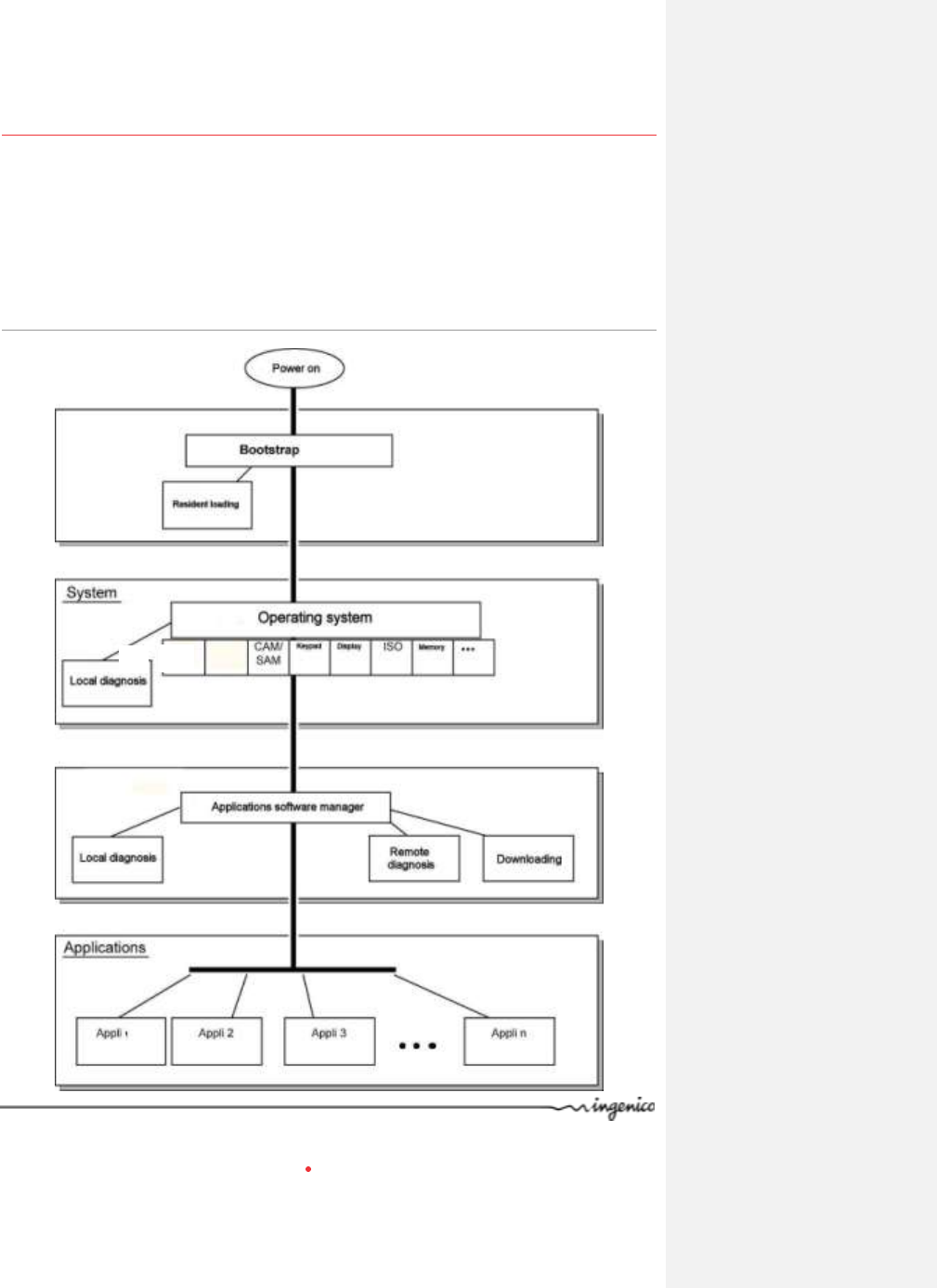
Technical manual _iWL220/250
ICO_MKP_009_GU_EN_V4
41/60
Copyright © 2010 Ingenico
All rights reserved
6. Software
The terminal has a software architecture that supports several applications coexisting
without mutual interference.
The OS is multitask, real-time and pre-emptive. The inputs/outputs are managed under
interruptions. This means the peripherals can be processed simultaneously, and thus
improves the terminal's performance. It can be downloaded to FLASH memory.
6.1. Software architecture

Technical manual _iWL220/250
ICO_MKP_009_GU_EN_V4
42/60
Copyright © 2010 Ingenico
All rights reserved
The software architecture is divided into three levels:
System
Multi-application manager
Independent applications
The system manages access to all the terminal's peripherals. Access is completed via
standard C primitives for all the input/output peripherals (keypad, printer, etc.) and via
specific primitives for other peripherals (smart cards and magnetic stripe cards). Further,
the system takes charge of memory management. It allocates memory space to the
software applications and controls access.
The multi-applications manager is the entity that calls on the various applications
downloaded in the terminal in response to the various events that occur in the terminal.
The applications are modeled around the demands made by the multi-applications
manager. Each request or input point represents a processing operation to be performed.
Each application manages the execution of these processing operations according to its
specifications. This standardization based on input points simplifies the implementation of
the applications on terminals. The iWL2xx provides natural access to the modularity
concepts and improves the maintainability and quality of the applications.
6.2. Memory space allocation
This part describes the memory usage as it is known at the present moment, this is subject
to change.
Example of a rough memory space allocation for a 16MB Flash + 16MB SDRAM
configuration.
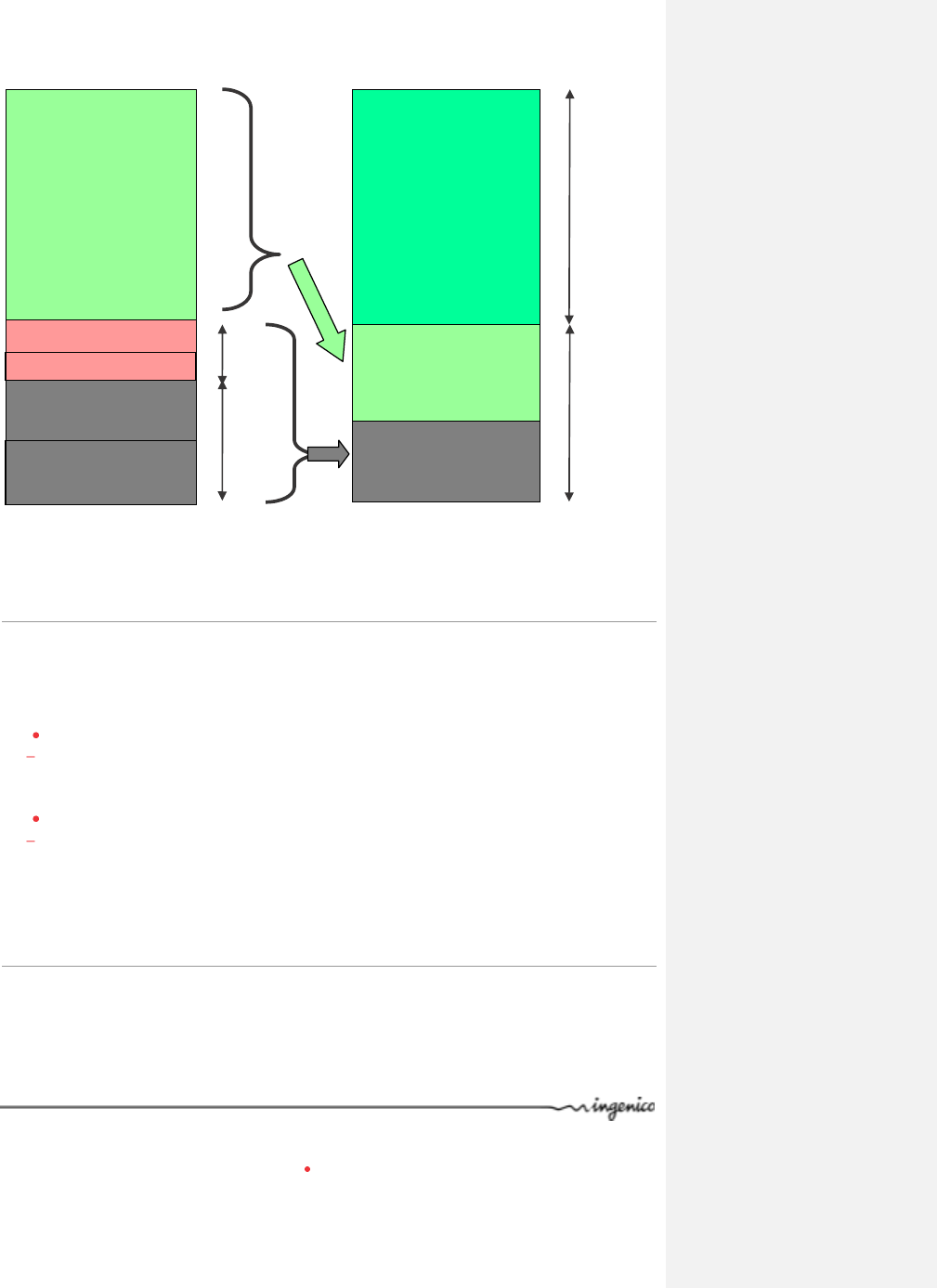
Technical manual _iWL220/250
ICO_MKP_009_GU_EN_V4
43/60
Copyright © 2010 Ingenico
All rights reserved
6.3. Software security management
The terminal is designed to execute authentic software only and to this in a ranked context.
The terminal performs the following checks
During a software download, the terminal checks:
Its authenticity, by checking its signature with the RSA algorithm with RSA-2048
algorithm.
Before loading a software from Flash to SDRAM, the terminal checks:
Its authenticity, by checking its signature with the RSA algorithm with RSA-2048
algorithm.
6.4. Operating system
6.4.1. Bootstrap
Bootstrap is resident.
Applications
~ 10.7 MB
SSL ~0.7 MB
EMV ~0.4 MB
Telium 2 Manager ~1.1
MB
OS + Drivers
~3.1 MB
1
16
6
M
MB
B
F
FL
LA
AS
SH
H
1
16
6
M
MB
B
S
SD
DR
RA
AM
M
4.2 MB
1.1 MB
10 MB
6 MB
System code
~2.95 MB
Applications code
~3 MB
Applications
Data
~10 MB
10 MB

Technical manual _iWL220/250
ICO_MKP_009_GU_EN_V4
44/60
Copyright © 2010 Ingenico
All rights reserved
The bootstrap very briefly takes control of the terminal following each powering up to
perform the initialization and the self-test. Then it automatically runs the OS which in turn
starts the applications manager.
Thus the Bootstrap provides the following functionalities:
Memory and checksum self-test;
Local download of the OS if absent;
OS authenticity check and start-up.
6.4.2. Operating system (OS) characteristics
The OS is downloaded (locally or remotely) into the memory. It is upgradeable. After a few
fractions of a second following powering up, it takes control. It checks the presence,
integrity and authenticity of the system components and application present in the
terminal.
The maintenance subsystem takes control in the following cases:
if no authentic application is present;
or if a manual action by the operator is made when powering up;
or if it is activated by application.
The maintenance subsystem ensures, among other things, the downloading of the
applications.
The OS ensures the start of the multitask core and then runs of the application by making a
set of services available to them:
Multitask management: Availability of a pre-emptive real-time environment, based
on interruptions, events and mail boxes. This management enables simultaneous
processing, which improves the terminal's performance.
Input/output management: This is carried out under interruptions, generally in
buffered mode. Thus, the applications developer enters a "conventional" C context.
System alarms management: Certain incidents (e.g. swipe card reading error)
detected by the OS are recorded. They can be used later by the maintenance
subsystem during remote or local diagnostics.
Application alarms management: A number of incidents detected by the
applications can be saved by the OS at their request. This recording is used later as
in the case of system alarms.
Application isolation management: The OS provides the mechanisms described in
the section on software isolation and memory protection. Between software
isolation is managed by an MMU (Memory Management Unit).

Technical manual _iWL220/250
ICO_MKP_009_GU_EN_V4
45/60
Copyright © 2010 Ingenico
All rights reserved
Applications download management: The OS offers the downloading services
described in the section "Software download"
6.5. Manager
The main functions offered by the manager are the following:
Application management;
Terminal initialisation;
Terminal maintenance;
Card recognition and routing to the application.
When EMV DC module is present, it selects the application:
EMV applications (conform with EMV level 2);
non EMV applications.
6.5.1. Terminal initialisation
6.5.1.1. Operating requirements
To function, the terminal has to be equipped with its OS, the applications manager and at
least one application. If one of the three components is missing, the terminal warns the
operator who has to load it.
If no application is initialized, the applications manager displays a message asking for an
application to be initialized.
If at least one application is initialized, the terminal is operational. The applications manager
then awaits an event to poll the software applications loaded in the terminal.
6.5.1.2. Common parameters Initialization
The applications manager is used to initialize the common parameters:
Date, time, message display language, phone network configuration data, Pin-pad
connection, local downloading of remote diagnostics.
6.5.2. Terminal maintenance
The terminal has maintenance functions for:
Properties;
Local downloading;
Diagnostics.
6.5.2.1. Properties
The properties function is used to print the following tickets:

Technical manual _iWL220/250
ICO_MKP_009_GU_EN_V4
46/60
Copyright © 2010 Ingenico
All rights reserved
List of applications downloaded into the terminal: version number, checksum, etc.
The applications manager prints this information for itself and for the operating
system;
Applications call time: remote collect, download, etc;
Total number of transactions in each application file contained in the terminal.
6.5.2.2. Download
The downloading function uses the parameters downloaded during the initialization of the
application manager.
The program update function is used to update the terminal by:
Using a special local downloading tool connected to the terminal;
Using a remote downloading tool;
Using a USB key.
6.5.2.3. Diagnostics
The diagnostic is used for:
Local diagnostics
saving consists of two groups of items:
Incident counters: used for repetitive-type incidents, when only the number of
occurrences is of use, e.g. the number of incorrect swipe readings.
Exceptional events. The information content depends on the type of incident.
Generally this is the date and time, and then information on the incident itself. These
events are saved in a revolving file where the most recent are kept.
Remote diagnostics
This allows the operator to make a call to the server to transfer information saved in the
terminal. The server can thus enrich a database for ensuring efficient monitoring of
equipment, propose preventive maintenance services, operating statistics, etc.

Technical manual _iWL220/250
ICO_MKP_009_GU_EN_V4
47/60
Copyright © 2010 Ingenico
All rights reserved
6.6. Software downloading
6.6.1. Downloading
Software can be downloaded:
Locally via the serial port (COM or USB).
Remotely via
the switched telephone network (PSTN)
X25
Ethernet
TCP/IP network.
By a USB key.
The techniques used:
data compression;
authenticity checking;
memory allocation management, etc.
best optimize the downloading operations.
Hence savings in downloading time, use security, ease of upgrade, and number of software
programs installed in the terminal.
6.6.2. LLT(Local Loading Tool)
The LLT is used for local software downloading.
The LLT is comprised of:
PC running Windows XP/ 2000 / NT4, Vista;
Ingenico downloading software;
PC-terminal connection cable.
Local downloading is carried out:
Using the PC with the LLT installed, on the USB slave port;
Automatic switching to the local loader of the OS.
Possible connection by USB slave port: speed about 8 Mbps.
Selection of the software to download is guided on the PC screen using an Explorer-type
windowing system (Windows Loader).
The downloading time of a 1Mo application is 4s by USB port.

Technical manual _iWL220/250
ICO_MKP_009_GU_EN_V4
48/60
Copyright © 2010 Ingenico
All rights reserved
6.6.3. Downloading by USB key
Downloading by USB key allows the downloading without any other tool.
Downloading time is equal to USB.
6.6.4. TMS (Terminal Management Server)
See “Terminal management system– TMS” Chapter.
6.6.5. Downloading and managing memory allocation in the terminal
Before the downloading, the system checks that the memory space is available.
Software downloading (possibly compressed) is done into flash.
If software is deleted, the system frees the space.
If software is upgraded, the system downloads the new software, checks it and
then deletes the old.
The whole memory zone remains used and usable. No zone is reserved for
upgrades.
When the terminal starts up (power up or reset) the applications are decompressed
and the code copied into RAM.
6.6.6. Improved software downloading
Includes the following characteristics:
Downloading via FTP TCP/IP and PPP for optimized downloading.
V32b downloading performance is:
– about 14.4 kbps on the original files.
Once the connection has been made with the V32b modem, the downloading of a
120 Kb application takes about 1 min.
Downloading can be done by IP via Ethernet on a SSL secured channel.
Data compression according to algorithm based on the Lempel-Ziv method ensuring
compression rates of about 40%.
For downloading, only the improved application will be downloaded.
In addition, the terminal manages this and not the remote server, which offers
operating security during multiple sources downloading.
Recall management in case of communication breakdown. This service enables an
interrupted downloading to be resumed at the same place where it had lost
connection and only to downloading the unfinished part.
The downloaded software is executed securely, using the authenticity check.

Technical manual _iWL220/250
ICO_MKP_009_GU_EN_V4
49/60
Copyright © 2010 Ingenico
All rights reserved
6.6.7. Starting the downloading
The downloading can be made:
Manually: The applications manager at the merchant request Launch a
downloading. This is especially the case of a program update or the addition of new
software into the terminal's memory. In this case the procedure is simplified to the
maximum.
Thus, the user starts the call from the applications manager by choosing the
upgrade function from the dialogue menus and keys. Dial-up and connection to the server
are automatic.
For an upgrade, the user has nothing to enter.
For a new software request, the user is guided on screen to make the choice. The
business's ID is not requested. The ID saved in the terminal is automatically
transmitted to the server.
Through management application: The application at the request of the centre or
the merchant. In this case, the downloading is fully automatic. The downloading
ticket lets the business know.
Through call scheduling: terminal can be set to call at schedule date and time to
regularly check of the content is up to date.

Technical manual _iWL220/250
ICO_MKP_009_GU_EN_V4
50/60
Copyright © 2010 Ingenico
All rights reserved
6.7. Development workstation
Introduction
The software is written in high level C language in a multi-applications environment.
Ingenico makes available all the software and equipment required for development. This
includes the documentation. Also, training sessions are offered.
Required configuration
The development workstation executes on a Pentium PC running under Windows
2000/XP/Vista.
Integrated environment (Eclipse) takes care of the software development phases:
Project creation,
edition,
compilation/edition of links under GNU,
signature,
downloading,
simulation,
remote debugger.
Supply
The development workstation comprises:
M²OS software licence which includes:
Operating system
Applications software manager
Libraries
Related documentation in PDF files.
User licence of SAT(Software Authentification Tool);
User licence of LLT (Local Loading Tool);
RSA Card and smart card reader for signing applications software.
Related services
Technical support
Lasts 6 months following the training.
It includes access to the hot-line, and to the updates of the documentation and software
during this period.
Software terminal package
Software packages are available allowing easy development for applications (EMV level 2
…)

Technical manual _iWL220/250
ICO_MKP_009_GU_EN_V4
51/60
Copyright © 2010 Ingenico
All rights reserved
7. TMS
7.1. Introduction
Ingenico developed its own Terminal Estate Management System called IngEstate. It is a
link between an organisation with an estate of payment terminals and their merchants. It
allows users to remotely manage payment terminals, modify their software content and
interact with merchants.
7.2. Basic functions
The basic functions are:
be able to locally download software on a terminal using a direct cable link (usually
RS232)
be able to remotely download software on a particular terminal using modems and
IP connections
be able to remotely download applications and configuration updates to a large
estate of terminals
be able to upload terminal configurations and check software status
be able to inform merchants when terminals are out of use during maintenance
periods
7.3. Advanced functions
The advanced functions are extremely various, with new ones being requested frequently:
draw statistics and reports about terminal configurations
optimise automatic call scheduling/download balancing for large estates of
terminals
be able to display written messages on the terminal, using the display or the printer
be able to easily configure a complete terminal (i.e. several applications) and to
download it in one operation
be able to analyse the status of terminal software and do only delta downloads (i.e.
only the parts that are damaged or need updates)
be able to download to either a PIN Pad or a terminal when connected;
Customise the system easily
Integrate with systems such as SAP easily
… and many others

Technical manual _iWL220/250
ICO_MKP_009_GU_EN_V4
52/60
Copyright © 2010 Ingenico
All rights reserved
7.4. Customer savings with Ingenico TMS solution
The most obvious cost saving is not having to send a technician to service the terminal at
the merchant location. Many other costs savings are derived from the ability to have a
“clean” estate; better diagnostics and remote software repairs mean less shipping of
replacement terminals, less downtime, less mail and phone communication costs, more
efficient update campaigns, etc.

Technical manual _iWL220/250
ICO_MKP_009_GU_EN_V4
53/60
Copyright © 2010 Ingenico
All rights reserved
8. Glossary
B
Bluetooth: Short-range wireless connection standards
Bps (Bits per second): The unit of measurement for the rate at which data is transmitted
C
CDMA (Code division multiple access): A spread-spectrum approach to digital transmission.
With CDMA, each conversation is digitized and then tagged with a code. The mobile phone
is then instructed to decipher only a particular code to pluck the right conversation off the
air.
Cryptography: Information security (encryption and decryption of data)
D
DES: Data encryption standard, a symmetrical encryption algorithm
E
EAP: Authentification protocol used with Radius server.
EAP-TLS : EAP with TLS authentification (require client and optional root certificate)
EAP-TTLS : EAP with Tuneled TLS authentification (require optional root certificate only)
EAP-PEAP : EAP with tunneled authentification (required optional root certificate)
EAP-MD5 : non secured EAP protocol mainly used for Ethernet only.
EMV: EMV stands for Europay Mastercard Visa and is the new EFTPOS standard that enables
with chips to be accepted anywhere in the world. It offers increased security by allowing
information identifies the cardholder to be stored on the chip.
EMV Level 1: EMV approval level for mechanical and electrical processing (and driver
software), which guarantees interoperability between card and terminals.
EMV Level 2: EMV approval level for software layer (or kernel), which allows a transaction to
be carried out an EMV card.
Encryption: The transformation of data, for the purpose of privacy, into a unreadable
format until reformatted with a decryption key.
Ethernet: A network cabling system.

Technical manual _iWL220/250
ICO_MKP_009_GU_EN_V4
54/60
Copyright © 2010 Ingenico
All rights reserved
F
Flash: Non-volatile memory.
Frequency: A measure of the energy, as one or more waves per second, in an electrical or
light-wave information signal. A signal’s frequency is stated in either cycles-per-second or
Hertz (Hz).
G
GSM: Global system for mobile communication, a world standard for digital wireless
transmissions. GSM is the most widely used standard in the world today with more than 150
million users worldwide.
I
ISDN: Integrated services digital network
ISO: International organization for standardization is a global network that identifies what
international standards are required by business, government and society, develops them
in partnership with the sectors that will put them to use, adopts the by transparent
procedures based on national input and delivers them to be implemented worldwide.
ISO-8583: International standard covering EFT messaging.
L
LAN: Local area network, a data communication network, typically within a building or
campus, to link computers and peripherals devices under some form of standard control.
LCD: Liquid crystal display.
LED: Light emitting diode.
LLT: Local loading tool
M
Modem: Modulator/DEModulator, a hardware device which converts digital data into
analog and vice versa to enable digital signals from computers to be transmitted over
analog telephones lines.
MSR: Magnetic stripe reader
O

Technical manual _iWL220/250
ICO_MKP_009_GU_EN_V4
55/60
Copyright © 2010 Ingenico
All rights reserved
Operating system: A software program that manages the basic operations of a computer
system. These operations include memory apportionment, the order and method of
handling tasks, flow of information into and out of the main processor and to peripherals,
etc.
P
PCI PED: Payment card industry PIN entry device, a security specification for EFT terminals,
designed to secure the PIN information stored in a terminal from fraudulent activity.
PED: PIN entry device, the secure customer interface module of a payment terminal.
PIN: Personal identification services, it is used as a security device on payment cards
requiring this code to be entered for further verification.
Protocol: Set of rules for organizing the transmission of data in a network.
PSTN: Public switching telephone network
R
RAM: Random access memory
RS-232: RS-232 is the serial connection found on IBM-compatible PCs. It’s used it for many
purposes, such as connecting a mouse, printer, external modem, and various peripheral
devices to a PC.
S
SAM: Secure authentication module.
Smart card: A credit card-sized card with a microprocessor and memory.
SRAM: Static random access technology.
T
TCP/IP: (Transmission control protocol/ internet protocol) the standard set of protocols
used by the internet for transferring information between computers, handsets, and other
devices.
U
USB: USB is a plug-and-play interface between a computer and add-on devices (such as
keyboards, printers and other peripheral devices). With USB, a new device can be added to
your computer without having to add an adapter card or having to turn the computer off.

Technical manual _iWL220/250
ICO_MKP_009_GU_EN_V4
56/60
Copyright © 2010 Ingenico
All rights reserved
W
Wifi : Wireless fidelity, Wireless network.
Wifi 802.11 a : wifi on 5GHz band
Wifi 802.11 b : wifi on 2.4GHz band / 11Mb/s max
Wifi 802.11g : wifi on 2.4GHz band / 54Mb/s max
Wifi 802.11n : wifi up to 130Mb/s (in SISO mode) on 2.4GHz or on 5Ghz
Wifi SISO mode : single in, single out mode. Meaning 1 antenna only.


NON CONTRACTUAL DOCUMENT
This Document is Copyright © 2010 by INGENICO Group. INGENICO retains full copyright
ownership, rights and protection in all material contained in this document. The recipient
can receive this document on the condition that he will keep the document confidential and
will not use its contents in any form or by any means, except as agree beforehand, without
the prior written permission of INGENICO. Moreover, nobody is authorized to place this
document at the disposal of any third party without the prior written permission of
INGENICO. If such permission is granted, it will be subject to the condition that the recipient
ensures that any other recipient of this document, or information contained therein, is held
responsible to INGENICO for the confidentiality of that information.
Care has been taken to ensure that the content of this document is as accurate as
possible. INGENICO however declines any responsibility for inaccurate, incomplete or
outdated information. The contents of this document may change from time to time
without prior notice, and do not create, specify, modify or replace any new or prior
contractual obligations agreed upon in writing between INGENICO and the user.
INGENICO is not responsible for any use of this device, which would be non consistent with
the present document.
All trademarks used in this document remain the property of their rightful owners.

Ingenico
192 avenue Charles de Gaulle
92200 Neuilly sur Seine - France
Tél.: + 33 1 46 25 82 00 - Fax: + 33 1 47 72 56 95
www.ingenico.com
DIVxxxxA
Your contact